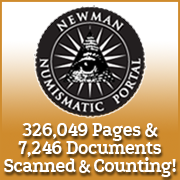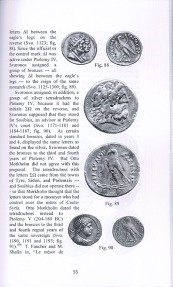
About UsThe Numismatic Bibliomania Society is a non-profit organization devoted to the study and enjoyment of numismatic literature. For more information please see our web site at coinbooks.org SubscriptionsThose wishing to become new E-Sylum subscribers (or wishing to Unsubscribe) can go to the following web page link MembershipThere is a membership application available on the web site Membership Application To join, print the application and return it with your check to the address printed on the application. Membership is only $20 to addresses in the U.S., $25 for First Class mail, and $30 elsewhere. For those without web access, write to: Terry White, Treasurer
AsylumFor Asylum mailing address changes and other membership questions, contact Terry at this email address: terrywhite5475@yahoo.com SubmissionsTo submit items for publication in The E-Sylum, just Reply to this message, or write to the Editor at this address: whomren@gmail.com BUY THE BOOK BEFORE THE COINSale Calendar |
- WAYNE'S WORDS: THE E-SYLUM JULY 31, 2016
- MORE NBS BENEFIT SALE LOTS ANNOUNCED
- BRYCE BROWN FIXED PRICE LIST AVAILABLE
- KOLBE & FANNING AT 2016 ANA WORLD'S FAIR OF MONEY
- '1792' AUTHORS AT 2016 ANA WORLD'S FAIR OF MONEY
- NEW BOOK: COUNTERFEITING AND TECHNOLOGY
- NEW BOOK: THE GOLD INDIANS OF BELA LYON PRATT
- NEW BOOK: PTOLEMAIC COINS, 2ND EDITION
- NEW BOOK: MEDALS OF JOSé DE SAN MARTíN
- NEW BOOK: THE AUCTIONEER
- BOOK REVIEW: CONFEDERATE NUMISMATICA
- BOOK REVIEW: COIN COLLECTING ALBUMS, VOLUME TWO
- NEWMAN PORTAL DIGITIZES THE BRASHER BULLETIN
- NOTES FROM E-SYLUM READERS: JULY 31, 2016
- FATHER AND SON: THE ENGINEERS BRUNEL
- ALBERT CHARLES ROESSLER, JR. (1883-1952)
- BUILDING THE LILLY COLLECTION, CONTINUED
- THE WILLIAM WOART TOKEN
- THE J.B. SCHILLER NEW ORLEANS COUNTERSTAMP
- SELECTIONS FROM PRESIDENTIAL AUCTION 86
- THE CLOISTERS ACQUIRES RARE LATE MEDIEVAL MEDAL
- CARNEGIE HERO MEDAL WINNER'S GRAVE TO GET PLAQUE
- ON SHIPWRECK SALVAGE
- COIN HOARD FROM THE TIME OF EMPEROR CONSTANTINE
- MUSEUM SEEKS FUNDS TO PURCHASE WOLD NEWTON HOARD
- HIGHLIGHTS OF JACQUIER’S AUCTION 42
- TURTLES AND TORTOISES ON ANCIENT COINS
- ARTICLE HIGHLIGHTS 1933 GEORGE V PENNY SALE
- STACKS-BOWERS 2016 ANA SALE CURRENCY SELECTIONS
- COUNTERFEITING MASTERMIND EXTRADITED TO U.S
- MAN TRIES SPENDING HOMEMADE $MILLION BILL
- BEP RESEARCHING NEW ANTI-COUNTERFEITING MEASURES
- KOREAN WAR U.S. MARINE HORSE WINS DICKIN MEDAL
- RUSSIANS PROMOTE CAT FOR NEW BANKNOTE
- FEATURED WEB SITE: NUMISMATIC FAKES
Click here to access the complete archive
To comment or submit articles, reply to whomren@gmail.com
WAYNE'S WORDS: THE E-SYLUM JULY 31, 2016
New subscribers this week include: L. Jankowski. Welcome aboard! We now have 1,995 subscribers. Can we get to 2,000 soon? Please tell your friends and new acquaintances about The E-Sylum. They'll be glad you did.
This week we open with updates on events at the upcoming ANA convention, a new price list, FIVE new books, two reviews and the latest specialty club publication to become part of the Newman Numismatic Portal.
Other topics this week include the Library of Coins albums, dealers A.C. Roessler and Robert W. Cornely, Josiah Lilly's U.S. gold collection, the William Woart token, shipwreck salvage, turtles on ancient coins, counterfeiting and anti-counterfeiting.
To learn more about Breen's Ugly Ducklings, Bela Lyon Patt's Gold Indians, Confederate Numismatica, department store coin shops, Richardson's Battery, BEP Presentation books, the Dickin medal, marine peril and dinglehoppers, read on. Have a great week, everyone!
Wayne Homren
Editor, The E-Sylum
MORE NBS BENEFIT SALE LOTS ANNOUNCED
George writes:
Barring late arrivals, we’re up to 26 lots. There is something in the sale for nearly everyone, including:
- Ted Craige’s original “1967 Franklin Hoard of United States Office of Gold Coins” by John J. Ford, Jr., with additional documentation;
- A handsome, special hardbound edition of the 2012 Prospero Collection of Spectacular Ancient Greek Coins;
- A Pre-Publication Draft of “1792: Birth of a Nation’s Coinage,” by Pete Smith, Joel Orosz, and Len Augsburger;
- An original 1921 copy of Henry Chapman’s landmark “Catalogue of the John Story Jenks Collection”;
- Thomas Jefferson’s 1790 Report Respecting Coins, Weights, and Measures, published in The American Museum, Philadelphia, 1790;
- An original “Invasion of Louisville” Video, an hour long, and one of only 11 VHS tapes made, accompanied by a DVD copy, for easy viewing;
- A “NUMIMATIC BIBLOMANIA” bourse table sign from the 1989 ANA Convention;
- Don Taxay’s “1971 Comprehensive Catalogue and Encyclopedia of United States Coins,” inscribed and signed by its mysterious author;
- Eighteen additional interesting and often unusual items!
16. KONVOLUT!* OVER 30 U.S. AUCTION SALES, ETC. An interesting and varied assemblage,
Donated by Joe Foster.
17. HORATIO R. STORER’S MEDALS, JETONS AND TOKENS ILLUSTRATIVE OF OBSTETRICS AND GYNÆCOLOGY. Original 1887 offprint. Ex Numismatic and Antiquarian Society of Philadelphia Library. Rare. Donated by Joe Foster.
18. TED CRAIGE’S ORIGINAL 1967 FRANKLIN HOARD OF UNITED STATES ASSAY OFFICE OF GOLD COINS, AN ANSWER TO ERIC P. NEWMAN. BY JOHN J.
FORD, JR. Ex August 13, 1983 Kolbe sale of the Craige Library, Lot 591, where it sold to John Adams for $2500 hammer. Original maroon
cloth-backed brown card covers. According to Ford, only 12 copies were originally made. Also present there, and here, is “correspondence
concerning this controversy, including photographic copies of the August, 1966 Eric P. Newman Numismatic Education Society report which
prompted Ford’s response, the text of Newman’s talk, “Perfection in Forgery”, given at the 1967 convention of the International Numismatic
Congress, and Ted Craige’s carbon copy of his letter and documentation, which is reproduced in the Ford work.”
Donated by John W. Adams.
A highlight of this NBS Benefit Sale, as indeed it would be of ANY noteworthy auction of classic American numismatic literature.
19. BREEN’S UGLY DUCKLINGS: THE UNITED STATES HALF CENTS, 1793-1857. AN EXERCISE IN DESCRIPTIVE CLASSIFICATION. [New York: F. C.
C. Boyd Foundation, 1959 (Berkeley, 1966)]. Approximately 275 8.5 by 11 inch loose leaves of typescript with numerous manuscript
corrections and additions, all in early photocopy. The initial draft, revised up to 1966, of this remarkable work, spectacularly brought to
fruition in 1983 by NBS co-founder Jack Collins.
Donated by John W. Adams.
20. SIGNED COPY OF DON TAXAY’S 1971 COMPREHENSIVE CATALOGUE AND ENCYCLOPEDIA OF UNITED STATES COINS. Première Edition, 1970.
Original binding, jacket. Fine. Inscribed and signed by the mysterious author, 9/3/75. Rarely found thus.
Donated by David Fanning.
21. STEPHEN SCHER’S THE CURRENCY OF FAME: PORTRAIT MEDALS OF THE RENAISSANCE. 1994. Original cloth, jacket. As new. Handsomely
illustrated.
Donated by Kolbe & Fanning.
22. SPECIAL EXTRA-ILLUSTRATED LEATHERBOUND EDITION OF THE ROBINSON S. BROWN, JR. COLLECTION OF LARGE CENTS. Superior Galleries,
1986. Original processed leather; slipcase, jacket. With 40 added photographic plates. Near new. A landmark collection, catalogued by NBS
co-founder Jack Collins.
Donated by Kolbe & Fanning.
23. MILDENBERG & HURTER’S THE ARTHUR S. DEWING COLLECTION OF GREEK COINS. ANS, 1985. Two volumes. Original matching cloth,
slipcase. Fine.
Donated by Kolbe & Fanning.
24. ASHTON & HURTER’S STUDIES IN GREEK NUMISMATICS IN MEMORY OF MARTIN JESSOP PRICE. 1998. Original cloth; jacket. An
important festschrift.
Donated by Kolbe & Fanning.
25. SPECIAL EDITION OF THE PROSPERO COLLECTION. SPECTACULAR ANCIENT GREEK COINS. January 4, 2012. Original cloth, jacket. Near
new. The Special Hardbound Edition of this landmark sale, extensively illustrated.
Donated by Kolbe & Fanning.
26. PRE-PUBLICATION DRAFT OF 1792: BIRTH OF A NATION’S COINAGE. By Pete Smith, Joel Orosz, and Len Augsburger. To be published in
2016. 372 pages, signed by the authors and housed in a 3-ring binder. Be the first on your block to read what is sure to be an
indispensable and comprehensive landmark work.
Donated by the Authors.
To read the earlier E-Sylum articles, see:
NBS BENEFIT SALE AT ANA CONVENTION (www.coinbooks.org/esylum_v19n28a02.html)
ADDITIONAL NBS BENEFIT SALE LOTS ANNOUNCED
(www.coinbooks.org/esylum_v19n29a02.html)
THE BOOK BAZARRE
BRYCE BROWN FIXED PRICE LIST AVAILABLE
Numismatic literature dealer Bryce Brown writes:
I have just uploaded a new Fixed Price List featuring over 300 out-of print numismatic books (with over 40 being signed by the author). The list can be viewed at http://brycebooks.squarespace.com/ under the "Reference Literature" tab.
To go directly to the Fixed Price List, see:
http://brycebooks.squarespace.com/storage/Lit-References-display.htm
KOLBE & FANNING AT 2016 ANA WORLD'S FAIR OF MONEY

Visit us at Booths 263 & 362 at this year's World's Fair of Money from August 9-13 in Anaheim, California!
We will be bringing a selection of new and rare books, plus a few special items to check out, including a remarkable group of important letters that we will be discussing in more detail shortly. We will also be offering a number of standard titles at a deep discount, so be sure to stop by.
See you in Anaheim!
'1792' AUTHORS AT 2016 ANA WORLD'S FAIR OF MONEY
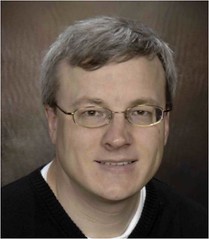
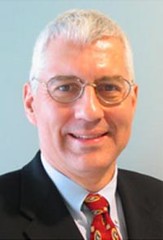
Augsburger and Orosz
Len Augsburger passed along this notice for numismatic bibliophiles and other attendees of next month's American Numismatic Association World's Fair of Money in Anaheim, CA.
Joel Orosz and Len Augsburger, numismatic authors, will have a one-day table (#261) at the ANA on Wednesday, August 10. On display will be a current draft of 1792: Birth of a Nation’s Coinage, to be published by Ivy Press and presently in layout, written by Orosz and Augsburger with co-author Pete Smith. We will also have Newman Numismatic Portal SWAG to distribute. It’s a set of two – collect them all!

NEW BOOK: COUNTERFEITING AND TECHNOLOGY
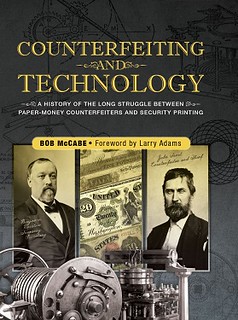 Whitman Publishing announces the upcoming release of Counterfeiting and Technology: A History of the Long Struggle Between Paper-Money
Counterfeiters and Security Printing, by Bob McCabe. In 480 pages this narrative covers the origins and development of paper and printing; the
formation of engraving companies in America, particularly in the melting pot of Philadelphia; the measures taken by the Secret Service and the Bureau
of Engraving and Printing against counterfeiting; and the scoundrels who regularly advanced their careers through forgery and inadvertently
encouraged new technology. The book will debut September 20, 2016, and before then can be pre-ordered from booksellers and hobby shops nationwide and
online (including at www.Whitman.com), for $39.95.
Whitman Publishing announces the upcoming release of Counterfeiting and Technology: A History of the Long Struggle Between Paper-Money
Counterfeiters and Security Printing, by Bob McCabe. In 480 pages this narrative covers the origins and development of paper and printing; the
formation of engraving companies in America, particularly in the melting pot of Philadelphia; the measures taken by the Secret Service and the Bureau
of Engraving and Printing against counterfeiting; and the scoundrels who regularly advanced their careers through forgery and inadvertently
encouraged new technology. The book will debut September 20, 2016, and before then can be pre-ordered from booksellers and hobby shops nationwide and
online (including at www.Whitman.com), for $39.95.
Since the “invention” of paper during China’s Tang dynasty, legitimate authorities and equally determined and imaginative rogues have fought in an attempt to improve (or copy) the technology and security of paper money. Historian McCabe captures their stories in vivid detail, from colonial times to the present day. Counterfeiters, mostly previously unknown or unrecognized for their dishonest cleverness, are finally brought to light, along with the stories of those who sought to capture them. McCabe follows the technology of American currency—from paper-making to fugitive inks to roller presses—from early colonial attempts to the modern era.
Larry Adams, Curator of Iowa’s Higgins Museum of National Bank Notes, wrote the foreword to Counterfeiting and Technology. “Bank notes have affected nearly every aspect of our lives and history, yet few people know anything about the art and science of this work, which, due to its nature, is shrouded in mystery,” Adams says. “McCabe has traveled to many of the largest cities in the eastern United States to ferret out original materials in libraries, museums, historical societies, and the National Archives to document this story, and from that material he has woven the fabric of a tale full of heroes and villains acting out their roles on the stage of American history.”
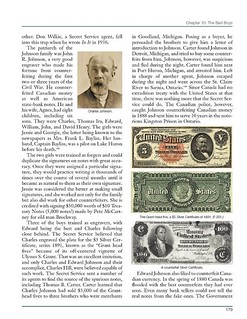 Whitman Senior Associate Editor Caitlyn Trautwein says, “Often the very men who attempted to counterfeit the currency of the time pushed
innovators to greater refinements, always seeking designs and securities that fell in line with the highest form of the art. Comparisons between
genuine and counterfeit bills and explanations as to what methods the counterfeiters used to do their work are recalled with such acumen that one
could believe McCabe was actually there, interviewing the men himself.”
Whitman Senior Associate Editor Caitlyn Trautwein says, “Often the very men who attempted to counterfeit the currency of the time pushed
innovators to greater refinements, always seeking designs and securities that fell in line with the highest form of the art. Comparisons between
genuine and counterfeit bills and explanations as to what methods the counterfeiters used to do their work are recalled with such acumen that one
could believe McCabe was actually there, interviewing the men himself.”
Counterfeiting and Technology presents the history of paper money in a way that’s never been seen before. It combines chemistry and artistry, inventions and escapades, tales of arrest and daring escapes. Collectors and historians of American money will love this engaging and informative narrative about our nation’s paper currency.
Because Whitman Publishing is the Official Supplier of the American Numismatic Association, ANA members receive a 10% discount off all direct purchases. The book can also be borrowed for free as a benefit of membership in the American Numismatic Association, through the Dwight N. Manley Numismatic Library.
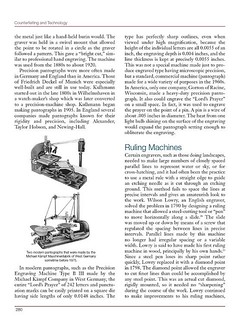
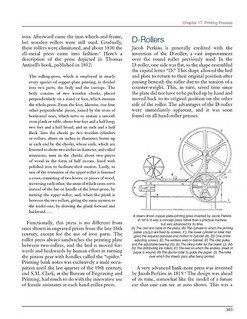
Counterfeiting and Technology
By Bob McCabe; foreword by Larry Adams
ISBN 0794843956
Hardcover, 8.5 x 11 inches, 480 pages
Full color
Retail $39.95 U.S.
Dennis adds:
This is quite a book, and I think coin collectors will find it as interesting as paper money collectors. Lots of interesting crossover appeal.
For more information, or to order, see:
Counterfeiting and Technology: A History of the Long Struggle Between Counterfeiters and Security Printing
(www.whitman.com/store/Inventory/Detail/Counterfeiting-and-Technology-A-History-of-the-Long-Struggle-Between-Counterfeiters-and-Security-Printing+0794843956)
NEW BOOK: THE GOLD INDIANS OF BELA LYON PRATT
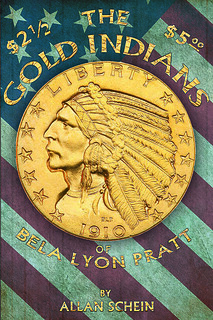 Author Allan Schein announces the release of his newest numismatic book, The $2½ & $5 Gold Indians of Bela Lyon Pratt. 18 months in the
writing this 415 page book contains more than 700 images of the Gold Indian coins and several hundred varieties and anomalies never before written
about. A soft bound full color volume, it will be formally debuted at the Anaheim ANA summer Money show in August 2016.
Author Allan Schein announces the release of his newest numismatic book, The $2½ & $5 Gold Indians of Bela Lyon Pratt. 18 months in the
writing this 415 page book contains more than 700 images of the Gold Indian coins and several hundred varieties and anomalies never before written
about. A soft bound full color volume, it will be formally debuted at the Anaheim ANA summer Money show in August 2016.
The $2½ & $5 Gold Indians of Bela Lyon Pratt is the first comprehensive book ever written exclusively about this popular and unique American coin series. Designed by Boston sculptor Bela Lyon Pratt in 1908, they are the only U.S. coins ever produced with a "sunken relief". Pratt's Indian is based upon the image of Brulé Sioux Chief Hollow Horn Bear. The chapter describing his identification is a fascinating and informative factual clarification of its design, the participating characters, as well as a detailed repudiation of other erroneous works published on the topic.
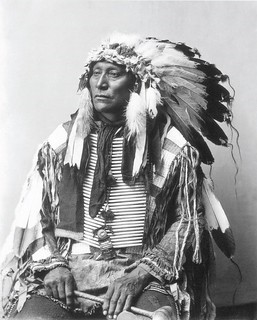
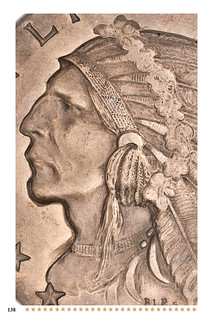
The Gold Indians of Bela Lyon Pratt includes an extensive biography of Pratt, his education and sculptural history. Much of it in his own words excerpted directly from an archive of more than 1,000 letters written by his own hand. Numerous images from the Pratt family photo archives are presented in print here, for the first time anyplace in more than 100 years.
Numismatic contents include the most complete and up to date information available with chapters on the coins design elements, comparisons of the changes made from the original plasters to the production issues. It includes; grading the gold Indians, Data sheets with specifics about values, rarities, auction records, unusual varieties and attributions, images of some of the finest examples ever encapsulated, numerous charts, a photographic grading section and more. Every date, branch mint issue and proof coin of both denominations are presented clearly and concisely, visually and descriptively. This invaluable reference is designed to be a complete, up-to- date handy guide for every collector and dealer, beginner or professional.
The $2½ & $5 Gold Indians of Bela Lyon Pratt presents this talented sculptor as the artistic giant he truly was until his untimely death at the age of 49, in 1917. His tremendous talent, sculptural innovativeness and creativity will, once better known in numismatic circles, forever bring BLP out from under the shadow of Saint Gaudens to stand in his own right as an immense talent and highly accomplished American sculptor.
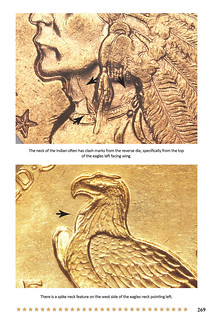
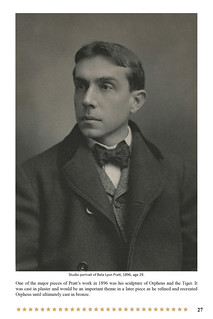
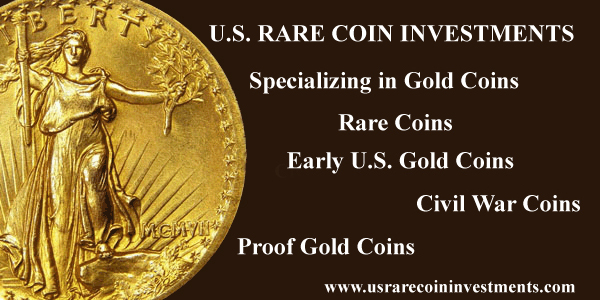
NEW BOOK: PTOLEMAIC COINS, 2ND EDITION
Svetolik Kovacevic of Ancient Numismatic Enterprise writes:
We are distributors of revised and expanded second edition of Richard Hazzard's book on Ptolemaic coins. This is very important book for any scholar or collectors of Ptolemaic coins that was way overdue as first edition was sold out within weeks in 1995.
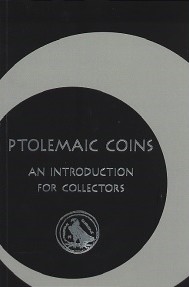 Ptolemaic Coins: An Introduction for Collectors By Richard A. Hazzard - Second 2015 Revised Edition Kirk and Bentley, Toronto, 2015.
Second revised edition. 195 pages with numerous photographic illustrations. An excellent survey of Ptolemaic coin of Egypt. Card covers. Just
published in very limited print run.
Ptolemaic Coins: An Introduction for Collectors By Richard A. Hazzard - Second 2015 Revised Edition Kirk and Bentley, Toronto, 2015.
Second revised edition. 195 pages with numerous photographic illustrations. An excellent survey of Ptolemaic coin of Egypt. Card covers. Just
published in very limited print run.
Table of Contents:
Foreword
Abbreviations
Acknowledgments
Map: Cities of the Ptolemaic Kingdom circa 240 BC
1. Portrait Coins
2. Coinage by Delta
3. The Standard Silver Tetradrachm or Stater
4. The Debasement of the Silver
5. The Bronze Coinage
6. A Look at Five Ptolemaic Finds
7. The Uses of Coinage Under the Ptolemies
8. Some Final Thoughts
Value of the Silver Tetradrachm in Bronze Coinage Ancient Authors Mentioned in the Text Select Catalogue Select Bibliography Index
Available at Vcoins.com/ANE from Ancient Numismatic Enterprise at US $60.00 + shipping.
For more information, or to order, see:
PTOLEMAIC COINS: AN INTRODUCTION FOR COLLECTORS BY RICHARD A. HAZZARD - SECOND 2015 REVISED EDITION - JUST PUBLISHED
(www.vcoins.com/en/stores/ancient_numismatic_enterprise/9/
product/ptolemaic_coins_an_introduction_for_collectors_by_
richard_a_hazzard__second_2015_revised_edition
__just_published/673298/Default.aspx)
NEW BOOK: MEDALS OF JOSé DE SAN MARTíN
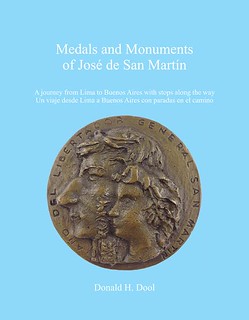 Medals and Monuments of José de San Martín
Medals and Monuments of José de San Martín
A journey from Lima to Buenos Aires with stops along the way
By Donald H. Dool
Some twenty years ago, while working in Argentina, the author became interested in collecting San Martín commemorative medals. As many of these had to do with the inauguration of monuments honoring San MartSan Lorenzo, the next step was photographing the monuments. The resulting book contains photographs of over eighty monuments in Peru, Chile and Argentina and where applicable the associated medal. Over 11,000 miles were traveled by bus in the three countries along with an untold number of taxis, commuter trains and airplanes.
Signed copies of the book are available from the author at: dool@comcast.net .
Price: $35.00 plus $4.00 S&H to US addresses.

NEW BOOK: THE AUCTIONEER
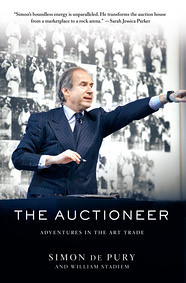 The auctioneer’s job is an odd one, borrowing elements from the stage and from the circus: It involves an actor’s ability to dominate an
audience, moving the proceedings along at a brisk clip and slowing down when he feels that a bidder can be enticed to go beyond his intended limit. A
touch of humor and flamboyance is fine—at parties, one Sotheby’s auctioneer would greet his guests with a parrot on his shoulder—but not too much: He
is the ringleader, not one of the clowns.
The auctioneer’s job is an odd one, borrowing elements from the stage and from the circus: It involves an actor’s ability to dominate an
audience, moving the proceedings along at a brisk clip and slowing down when he feels that a bidder can be enticed to go beyond his intended limit. A
touch of humor and flamboyance is fine—at parties, one Sotheby’s auctioneer would greet his guests with a parrot on his shoulder—but not too much: He
is the ringleader, not one of the clowns.
In “The Auctioneer,” Simon de Pury, former chairman of Sotheby’s Europe, provides a comedy-rich account of his exploits in the treacherous art world, along with pen portraits of some of his closest allies and enemies. Known as the Mick Jagger of the auction room, he was painted by Eric Fischl sitting in his Caraceni suit with a girlfriend stark naked in his lap.
Born in Basel in 1951, the son of a baron, the young Mr. de Pury planned to become an artist but after three failed attempts to sell his artwork in New York decided to become an art dealer instead. Having attended a Sotheby’s training program in London—dismissed by his parents as a course for spoiled brats “who couldn’t get into Oxford on a bus tour”—he got an unpaid job at the Sotheby’s reception desk that involved referring customers with quality items to the experts upstairs and politely dashing the dreams of those whose heirlooms belonged in a flea market.
We get a glimpse of him in action in Monaco. According to Monegasque law, only a licensed local auctioneer can perform an auction. Wilson got around this by hiring one to stand next to him. But she brought down the gavel too fast, cramping Wilson’s style, “all foreplay without the pleasure of conclusion,” as he put it. “By the end of the sale,” Mr. de Pury writes, “he was basically holding her arm and bringing it down exactly when he wanted. He had turned her into his robot.”
To read the complete article, see:
Ringmaster With a Gavel
(www.wsj.com/articles/ringmaster-with-a-gavel-1469748425)
THE BOOK BAZARRE
BOOK REVIEW: CONFEDERATE NUMISMATICA
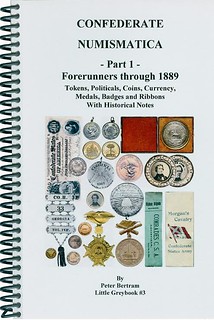 Peter Bertram's new book on Confederate Numismatica is downright unbelievable! The depth and breadth of this work is
amazing. I had no idea that some of the items even existed! He listed items you could easily pass over at a flea market thinking they were junk.
Peter Bertram's new book on Confederate Numismatica is downright unbelievable! The depth and breadth of this work is
amazing. I had no idea that some of the items even existed! He listed items you could easily pass over at a flea market thinking they were junk.
Confederate Forerunners (Pre-War to 1861)
The work is broken into three segments based on time. First is the era of Pre-War to 1861 with many tokens, political campaign tokens and
ribbons, and secession items. I had never seen many of these items in the eight to ten years spent researching the Confederate cent, nor
did I know they existed. Peter included some history with most of the items listed. And, the book is in color!!
Confederate Wartime (1861-1865)
The second era is Wartime 1861-1865. During this period of time coins of all metals were hoarded, both North and South. This resulted in
counterstamped coins and a lot of paper being printed and used for money. He has included the several tokens that George Corell has
described as “Confederate Orphan Coins.” Some of these were produced in the South and some in Paris, France. Of course, he dives into the
tokens and coins produced by Robert Lovett, Jr. He covers the Confederate cent and the later restrikes by Capt. John W. Haseltine and the
infamous Robert S. Bashlow. Bashlow produced a plethora of Confederate cent restrike items which Peter covers nicely.
The Confederacy inherited the tools, dies, and bullion when they took control of the three mints within their territory. When these actions occurred, the mint personnel continued to strike coins for a time. In all cases the dies used were U.S. dies in varying states of wear. Peter dedicated several pages and many images to describing how to detect the coins struck under Confederate control. The Confederate half-dollar is part of this discussion.
The next section of the Wartime 1861-1865 era is the paper produced by and for the Confederacy. There are many pages and images dedicated to this subject. Confederate paper is a study unto itself and has been done by several people over time, not the least of which was Capt. John W. Haseltine. Again, historical information is included.
The final section covers badges, medals, and ribbons. There are several one-of- a-kind handmade items in this section. You will see the treasury seal made by George H. Lovett, Robert, Jr.’s brother. You can learn of the Great Seal of the Confederacy and the various copies. Also, the Stonewall Jackson medal produced in Paris, France is described with some history of the piece. It ends with a description of Jefferson Davis’ flight to evade capture by the Union Army. There are a number one-off medals and badges presented.
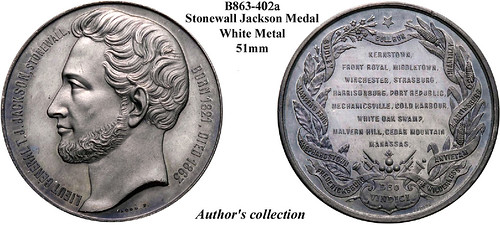
Confederate Postwar (1866-1889)
The final era is that of Post War 1865-1889. There were many one-off badges and ribbons and those manufactured for specific occasions and
groups. Many of the occasions were reunions of the various brigades. You need to see this section as you could easily pass over these
pieces in a flea market.
The book ends with descriptions of counterfeits. As Peter says, it is a shame this information has to be included, but as with most collectibles, the unscrupulous try to cash-in. This is a great guide book necessary for collectors of Confederate memorabilia.
Peter Bertram writes:
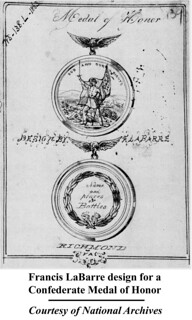 The book offers the first listing of Breckinridge/Lane 1860 Presidential Campaign medalets since Sullivan’s now classic 1981 reference.
Some 15 previously unlisted items are noted, including all four varieties of the striking ribbons based on the remarkable steel-plate engravings of
John C. Buttre.
The book offers the first listing of Breckinridge/Lane 1860 Presidential Campaign medalets since Sullivan’s now classic 1981 reference.
Some 15 previously unlisted items are noted, including all four varieties of the striking ribbons based on the remarkable steel-plate engravings of
John C. Buttre.
Interestingly, many collectors are not aware that two varieties of the “A United South” token are now known and the book lists and illustrates both.
With an appreciative nod to the work of Randall Wiley and Bill Bugert, the book includes a table and seven detailed panels to assist collectors in determining which 1861-O half dollars were struck under Confederate authority.
A detailed history of the Confederate Great Seal is included, along with detailed illustrations of eight collectable reproductions of the Seal.
All ten of the Davis Flight Medals and their story is told here for their first time in print.
The book defines nine Ladder Badge Types and three miscellaneous pieces with detailed text and illustrations.
If there were pickup lines for books, I'd use this one: "Where've you been all my life?" Confederate Numismatica fills a void in the canon of American numismatic literature. While a lot of information on the topic has been published over the years, it was scattered, uneven, incomplete and often downright incorrect.
Despite being a longtime numismatic bibliophile, I only learned about some of these items myself in the course of editing The E-Sylum over the last two decades.
As one example of Peter Bertram's thorough work in writing his new book Confederate Numismatica, see a later article in this issue which republishes a section on the J.B. Schiller counterstamp discussed in an earlier E-Sylum article, where it was incorrectly described as a "siege token".
Notes about shortcomings are mandatory in any review, and now that I've gotten past my original excitement, I'll address a couple minor things I noticed. First was the page and print size. To my aging eyes the print was small and the pictures were small, too, with most well under actual size. I'd be happy to buy a larger, more expensive deluxe version with actual-size photos (or larger)!
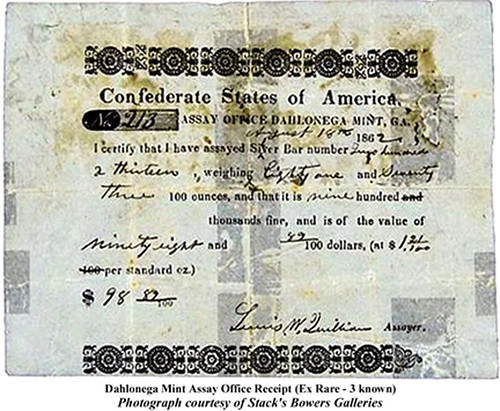
Another minor shortcoming is that even though the book does include a price guide, it's hard to find, being buried at the very end. Prices are the first thing many book buyers look for, so I would advertise the guide right on the cover, and remind readers throughout where to find it. Perhaps update the subtitle to ".. With Historical Notes and Price Guide", and footer notes: "See page 193 for pricing guide."
It's hard enough to compile all of this great information, and even more work sometimes to compile prices; since many of these items are extremely rare, price records are hard to find if they exist at all. Peter confirmed that compiling those three pages took almost as much time and cross-eyed effort as some of the major portions of the book. Collectors and dealers alike will find these estimates quite useful.
Confederate Numismatica is a landmark work, and Peter deserves many kudos for his efforts. This is something the numismatic world has lacked for far too long. See last week's article, linked below, for ordering information.
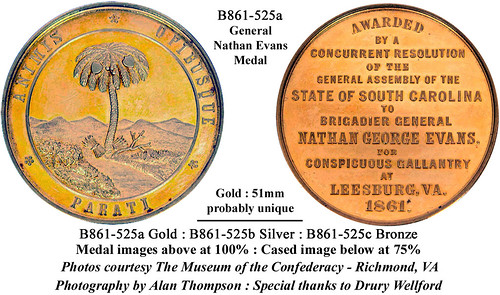
We'll all stay tuned for Part 2 of Peter's planned four-volume series. And of course, please do notify Peter of any missing items you're aware of for inclusion in his planned annual Confederate Numismatica Supplement.
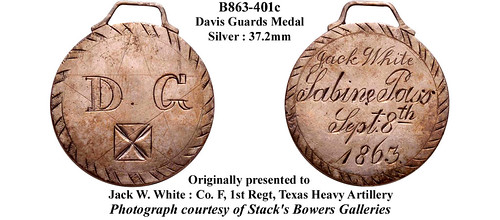
From the Introduction:
This book represents Part 1 of an attempt to start filling at least a little of the void in the literature of published information for collectors of Confederate tokens, badges, ribbons, etc. I believe that preserving the collectibles and memorabilia of Confederate veterans will be aided by the ready availability of information about them. That pretty much sums up my purpose here. Perhaps you could join me and participate in the effort?
Cataloging these treasures of Southern Heritage has been slow in coming. As the father of the effort, Mr. Lynn J. Shaw published the first reference in his 1989 little red book “Badges and Ribbons of the United Confederate Veterans and Sons of Confederate Veterans”. Updated in 1996, it only showed about 130 badges but for years was the only source of information and is now considered a classic and getting tough to find!
I then dabbled at it with a Newsletter from 1996 to 1999 and a few articles. So when my little Southern Cross of Honor book was very well received, I decided to return to this project. All this fast forwards us up to today and this little book you are holding. It is Part 1 of a planned three or four volume series cataloging Confederate numismatica. Part 2 will start in 1890 with the first UCV badges and will be “the UCV book”.
To read the earlier E-Sylum article, see:
NEW BOOK: CONFEDERATE NUMISMATICA, PART 1
(www.coinbooks.org/esylum_v19n30a04.html)

BOOK REVIEW: COIN COLLECTING ALBUMS, VOLUME TWO
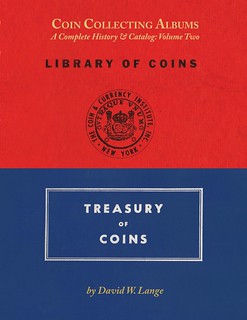 Welcome to this, the second volume in a series of books that will document the history of coin collecting albums produced in the United
States and catalog all of the varieties known for each publisher’s output. Volume One told the story of three publishers—The Beistle Company, Wayte
Raymond, Inc. and M. Meghrig & Sons—and it proved to be a massive undertaking of four years that resulted in a book of 288 pages. The present
work, Volume Two, is a somewhat less grand undertaking that addresses the works of a single publisher—The Coin and Currency Institute.
Welcome to this, the second volume in a series of books that will document the history of coin collecting albums produced in the United
States and catalog all of the varieties known for each publisher’s output. Volume One told the story of three publishers—The Beistle Company, Wayte
Raymond, Inc. and M. Meghrig & Sons—and it proved to be a massive undertaking of four years that resulted in a book of 288 pages. The present
work, Volume Two, is a somewhat less grand undertaking that addresses the works of a single publisher—The Coin and Currency Institute.
If the name Coin and Currency Institute is not immediately recognizable to the reader, its products certainly are widely known. The company continues to operate today, publishing updated editions of its signature titles— Paper Money of the United States, Gold Coins of the World and So-Called Dollars. There was a time, however, when it was just as well known for its extensive line of very popular coin albums that were issued under the banner Library of Coins. Though now long out of print, these coin albums are well remembered by those active in the coin hobby and business during the 1960s. They continue to enjoy good sales on the secondary market, and some coin dealers even feature clean copies of these old albums on their websites. The scarcer and more highly sought titles are apt to bring $100+ in their rare appearances on eBay and other online sales venues. The market for these albums is divided between those seeking them to store coins and those simply desiring to gather them as collectibles in their own right.
Sometimes it takes a visionary to plow new fields and lead the way for others. Together with his first volume on coin collecting boards, David has done just that for this subfield of numismatics, the study and collecting of storage and display products for coin collections.
While some have scoffed and dismissed the concept out of hand, that's a common reaction to new numismatic books and organizations. Some were dumbfounded when Augustus Heaton published his 1893 book on Mint Marks - why would anyone ever care about the presence or absence of a tiny letter on their coins? Similarly, the first studies on die varieties were dismissed by some as a silly, unnecesary fad. Yet no one in the hobby today would dispute their importance or fail to note a scarce mint mark or variety when selling a coin.
I would invite any skeptics to actually read David's books. Within their pages are interesting stories of hobby history and reams of previously unpublished information. Anyone investigating the nature and growth of the numismatic field in the 1950s and 60s would do well to study these books and learn the stories of the remarkable growth that occurred in that era.
As noted in the Introduction, this book is primarily a tale of the Capitol Coin Company and their products. Part one addresses the history of the company, the Friedberg family behind it, as well as their Coin and Currency Institute, which endures today. The remaining major parts are detailed catalogs of their Library of Coins and Treasury of Coins product lines.
The Capitol Coin Company had its roots in the 1930s. Founded by Robert Friedberg, it became the largest U.S. vendor of collectible coins from the 1950s through the 1970s. Yet it was little known among the general public, because most of its sales were through department stores throughout the country.
As a young collector myself growing up in that era, I often visited these coin departments in my hometown of Pittsburgh, PA. Dave had a similar experience growing up in San Francisco. The book details the rise (and eventual demise) of this giant retail empire, which served as a launching point for the coin storage products covered in the book.
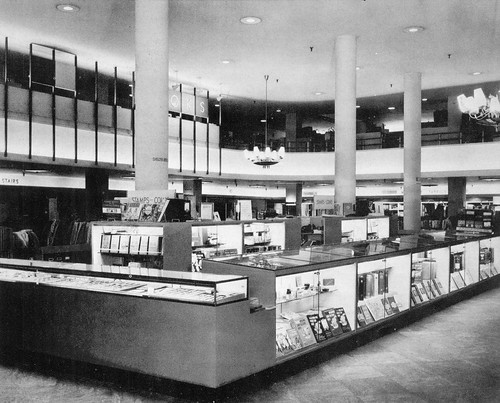
Capitol Coin Company's Coin and Stamp Department
at Baltimore's Hutzler's Store, Featuring
Library of Coins albums for sale
The book covers the history of the company, its struggles during WWII and its connection with the Minkus stamp company which had the direct contracts with the department stores. The stores wanted to give customers the impression that the departments were owned and operated by the stores themselves, so Jacques Minkus and the Friedbergs had to operate in anonymity behind the scenes.
Among previously little-known facts discussed in this book are some of the premier rarities in U.S. and world coinage that passed through the Friedberg's hands, including a 1787 Brasher Doubloon and an 1894-S Dime, both purchased over the counter in department store coin shops.
The book has interesting background on the market for coin storage products in the 1950s with the Wayte Raymond albums being the most popular. But Robert Friedberg saw that the existing lines of albums were not growing and changing with the hobby, and saw an opening for an improved product and began working on his concept as early as 1956. In 1959 the Library of Coins albums made their public debut. Below is an advertisement from the June 1959 Numismatic Scrapbook Magazine. For bibliophiles, next to it is a 1964 ad for six of the books written or published by Friedberg, many of which are still key references today.
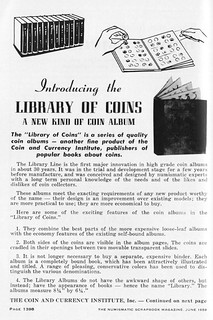
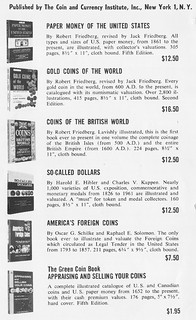
As noted, the bulk of the book is devoted to a catalog of the individual Library of Coins and Treasury of Coins albums. All are given Lange catalog numbers, and notes provide diagnostics for determining the particular edition or variant.
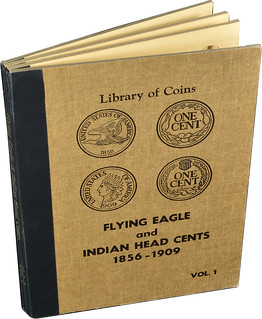 The full-color illustrations are stunning. I know David worked very hard with his printer to ensure that the colors came out looking
extremely close to the actual colors of the pictured albums. This is where the book shines.
The full-color illustrations are stunning. I know David worked very hard with his printer to ensure that the colors came out looking
extremely close to the actual colors of the pictured albums. This is where the book shines.
Coin Collecting Albums – A Complete History & Catalog: Volume Two, Library of Coins and Treasury of Coins is available from the author for $49.95. Shipping is $10 for priority mail in a sturdy box. I recommend it to E-Sylum readers and anyone with an interest in the history of our own hobby, especially skeptics who wonder what anyone could learn from studying these peripheral items; read it and you'll see - a lot.
For more information, or to order, see:
www.coincollectingboards.com
To visit the Coin & Currency Institute web site, see:
http://www.coin-currency.com/
To read the earlier E-Sylum article, see:
NEW BOOK: COIN COLLECTING ALBUMS, VOLUME TWO
(www.coinbooks.org/esylum_v19n11a03.html)
NEWMAN PORTAL DIGITIZES THE BRASHER BULLETIN
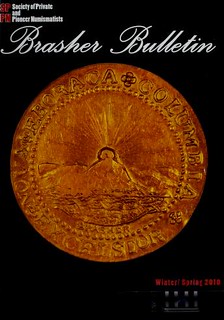 This week’s featured item on the Newman Portal is The Brasher Bulletin, the journal of the Society of Private and Pioneer
Numismatists (SPPN). The run on the Newman Portal spans the period from 1988 (volume 1) through 2014. While much of the public mindshare is focused
on pricier items such as territorial gold coins and assay bars, the Brasher Bulletin broadens its coverage to include all numismatic items of
western Americana, such as fractional gold pieces and 19th century tokens. The Newman Portal wishes to thank Don Kagin, SPPN president, for his
assistance with his project, and Wayne Homren, for providing his set for scanning.
This week’s featured item on the Newman Portal is The Brasher Bulletin, the journal of the Society of Private and Pioneer
Numismatists (SPPN). The run on the Newman Portal spans the period from 1988 (volume 1) through 2014. While much of the public mindshare is focused
on pricier items such as territorial gold coins and assay bars, the Brasher Bulletin broadens its coverage to include all numismatic items of
western Americana, such as fractional gold pieces and 19th century tokens. The Newman Portal wishes to thank Don Kagin, SPPN president, for his
assistance with his project, and Wayne Homren, for providing his set for scanning.
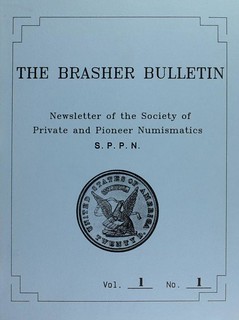 I recall attending one of the first (if not THE first) meetings of SPPN at an ANA convention. I've been a member from the beginning.
Also in attendance was Walter Breen. As we went around the room introducing ourselves and stating our collecting interests, Walter said, "I
collect information." While Walter had other less savory interests, his affinity for information is shared by all numismatic bibliophhiles.
I recall attending one of the first (if not THE first) meetings of SPPN at an ANA convention. I've been a member from the beginning.
Also in attendance was Walter Breen. As we went around the room introducing ourselves and stating our collecting interests, Walter said, "I
collect information." While Walter had other less savory interests, his affinity for information is shared by all numismatic bibliophhiles.
Although I don't collect pioneer gold, I've enjoyed reading every issue of The Brasher Bulletin, and saved them all these years while I waited for computer technology to catch up. I'm grateful that the club agreed to share this great information with the world through the Newman Numismatic Portal. Thanks! -Editor
Link to The Brasher Bulletin on the Newman Portal:
https://nnp.wustl.edu/library/publisherdetail/513367

NOTES FROM E-SYLUM READERS: JULY 31, 2016
More on the 1879 Weyl Want List
George Kolbe writes:
The lot description cited below, from GFK Sale 98, November 17, 2005, adds some context to the “1879 Weyl Want List” article in last week's Big E. Kolbe & Fanning sold another copy in their September 26, 2013 Sale 130. Please note that the referenced publication is a fixed price list, not an auction sale catalogue.
1804 Silver Dollar Wanted!
185 Weyl, Adolph. ites verzeichniss verkäuflicher münzen, denkmünzen und numismatischer bücher. Berlin, September 1879. (2), 90 pages, 2074
+ 329 listings.
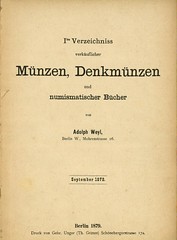 Following the firm’s listing of over 2,000 non-European (including North and South America, Australia, Africa, and the Near, Middle, and
Far East) überseeischen coins, medals, and tokens for sale, including four 1859 pattern half dollars in copper, is the firm’s Kauf-Gesuche!, or Want
List. Under Amerika, which encompasses both continents, are listed many rare American colonial pieces and federal issues, including early silver
dollars of 1794 and 1804, as well as 1836-1839 Gobrecht issues. Half dollars wanted include 1796 and 1797, quarter dollars of 1796 and 1804, and an
1802 half dime. Among large cents desired were the triumvirate of 1793, 1799, and 1804. Clearly, by the 1870s, American coins were being actively
collected by Europeans, the German Weyl firm was the leader in the field, and the level of numismatic sophistication was not to be
underestimated.
Following the firm’s listing of over 2,000 non-European (including North and South America, Australia, Africa, and the Near, Middle, and
Far East) überseeischen coins, medals, and tokens for sale, including four 1859 pattern half dollars in copper, is the firm’s Kauf-Gesuche!, or Want
List. Under Amerika, which encompasses both continents, are listed many rare American colonial pieces and federal issues, including early silver
dollars of 1794 and 1804, as well as 1836-1839 Gobrecht issues. Half dollars wanted include 1796 and 1797, quarter dollars of 1796 and 1804, and an
1802 half dime. Among large cents desired were the triumvirate of 1793, 1799, and 1804. Clearly, by the 1870s, American coins were being actively
collected by Europeans, the German Weyl firm was the leader in the field, and the level of numismatic sophistication was not to be
underestimated.
To read the earlier E-Sylum article, see:
THE 1879 WEYL WANT LIST (http://www.coinbooks.org/esylum_v19n30a08.html)
Quiz Answer: Who's in This 1913 Liberty Nickel Picture?
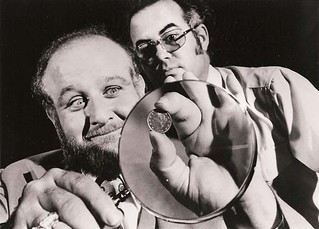 Last week Pete Smith asked who is the other man with actor Victor Buono in this classic still image from the TV series Hawaii
Five-O.
Last week Pete Smith asked who is the other man with actor Victor Buono in this classic still image from the TV series Hawaii
Five-O.
David Crenshaw writes:
The man who is looking over Mr. Buono’s shoulder is Robert Cornely. The owner of the coin, John Hamrick (World Wide Coin Investments), sent his associate, Mr. Cornely, with the coin to keep a close eye on it during the filming of the Hawaii Five-O episode.
David adds:
In the famous words of Paul Harvey, now, “The rest of the story!”
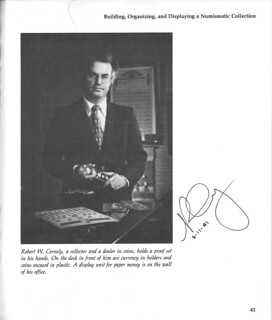 Thirty-six years ago my first job out of college I was a numismatist at Rare Coins of Georgia, Phipps Plaza, Atlanta, which Robert owned. A
couple of years later, Robert opened Lenox Stamp & Coin, Lenox Square, Atlanta. His wife, Cindy, and I managed that store.
Thirty-six years ago my first job out of college I was a numismatist at Rare Coins of Georgia, Phipps Plaza, Atlanta, which Robert owned. A
couple of years later, Robert opened Lenox Stamp & Coin, Lenox Square, Atlanta. His wife, Cindy, and I managed that store.
At the time, I was reading The World of Coins and Coin Collecting by David Ganz. The book's introduction had a picture of actor Victor Buono holding the 1913 Liberty Head nickel. There's also a picture of Robert on page 41 as an example of a coin collector and dealer in rare coins. I recall pointing the pictures out to Robert, and he shared with me the story about his role with the coin starring in an episode of the Hawaii Five-O television series. I asked Robert to autograph his picture. That book is in my library today.
To read the earlier E-Sylum article, see:
NOTES FROM E-SYLUM READERS: JULY 24, 2016 : Quick Quiz: Who's in This 1913
Liberty Nickel Picture? (www.coinbooks.org/esylum_v19n30a09.html)
Numismatic Friends of Sherlock Holmes Dinner
Greg Ruby writes:
The Fourth Garrideb will be in Anaheim, California for the American Numismatic Association’s World’s Fair of Money being held August 9-13, 2016 at the Anaheim Convention Center.
The Numismatic Friends of Sherlock Holmes Dinner will be held at 7P on Thursday, August 11, 2016 at Buca de Beppo, just a few blocks from the Convention Center. Both Sherlockians and Numismatists are invited to attend.
The dinner is purely social – no scholarly papers, no slideshows, no quizzes . . . just toasts.
For more information, see:
Numismatic
Friends of Sherlock Holmes Dinner to be held during the 2016 ANA World’s Fair of Money
(http://fourthgarrideb.com/2016/06/numismatic-friends-of-sherlock-holmes-dinner-to-be-held-during-the-2016-ana-worlds-fair-of-money/)
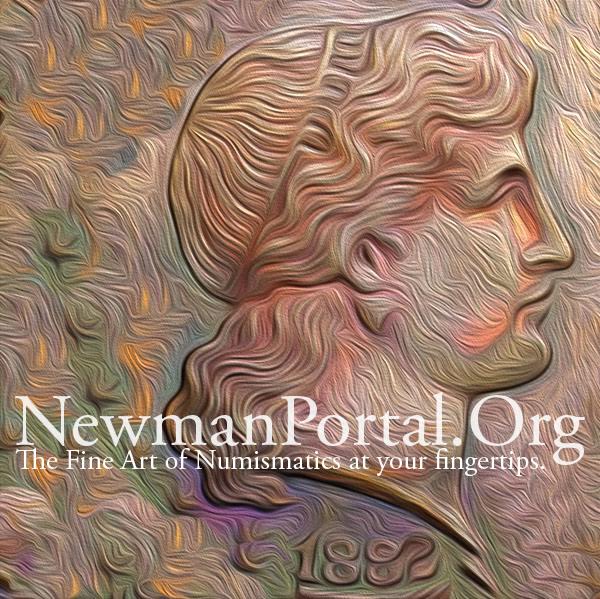
FATHER AND SON: THE ENGINEERS BRUNEL
In The E-Sylum of June 26 there was an item about the portrait on the new British bank note of Winston Churchill, No. 1 in the poll of the Greatest Britons. In this context, Joe Esposito wrote: "It is surprising that Brunel, who is largely unknown in the United States, was number two. Brunel was a great engineer, whose work included the Thames River Tunnel. When completed in 1843, the tunnel was hailed as a marvel, and a number of medals were struck to commemorate it."
The Brunel of the Thames River Tunnel was Marc Isambard Brunel (1769-1849). However, the Brunel who was No. 2 in the poll of the Greatest Britons was Marc's son, Isambard Kingdom Brunel (1806-1859).
Isambard Kingdom Brunel is considered one of the most innovative and prolific engineers of his time. He designed three famous ships—Great Western (1837), the first purpose-built transatlantic steamship; Great Britain (1843), which at the time was the largest steamer ever made and the first iron, screw-propeller driven vessel built as a transatlantic liner; and Leviathan (1858), later renamed Great Eastern, which at the time of construction was six times larger than any previous ship in the world. Brunel Junior also designed roads, 125 bridges, 25 railway lines with over 1,000 miles of track, numerous docks and piers, and the first prefabricated military hospital.
Isambard Kingdom Brunel and/or one of his famous ships are commemorated on coins of Gibraltar, the Falkland islands, Liberia, and Tuvalu. I attach the image of one of the three coins issued by the Falkland Islands which depicts the Great Britain and a medallion portrait of Brunel.
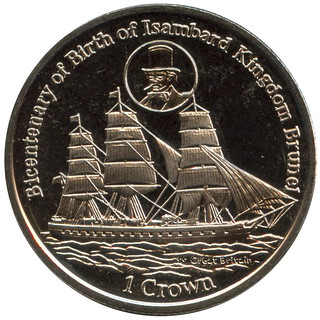 In case you wonder about the connection between the Falklands and the ship—in 1886 she sprang a leak when rounding Cape Horn and was forced
to take shelter in the Falkland Islands. Repairs proved too costly and the ship was sold to the Falkland Islands Company to be used as a floating
coal and wool storage hulk at Port Stanley. In 1937 Great Britain's hull was beached and abandoned for 33 years. In 1970 the hull was refloated,
placed on a giant pontoon barge and towed across the Atlantic Ocean to Bristol, England, to be restored to her original appearance in the same dry
dock in which she had been built in 1843. She is now a museum ship in Bristol.
In case you wonder about the connection between the Falklands and the ship—in 1886 she sprang a leak when rounding Cape Horn and was forced
to take shelter in the Falkland Islands. Repairs proved too costly and the ship was sold to the Falkland Islands Company to be used as a floating
coal and wool storage hulk at Port Stanley. In 1937 Great Britain's hull was beached and abandoned for 33 years. In 1970 the hull was refloated,
placed on a giant pontoon barge and towed across the Atlantic Ocean to Bristol, England, to be restored to her original appearance in the same dry
dock in which she had been built in 1843. She is now a museum ship in Bristol.
To read the earlier E-Sylum article, see:
THE KARSH PHOTO OF WINSTON CHURCHILL
(www.coinbooks.org/esylum_v19n26a29.html)
ALBERT CHARLES ROESSLER, JR. (1883-1952)
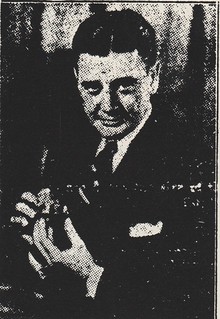 Albert Charles Roessler, Jr. (1883-1952), 1958 Washington Avenue, New York. Coin and stamp dealer, began trading as a stamp dealer in
Denver.
Albert Charles Roessler, Jr. (1883-1952), 1958 Washington Avenue, New York. Coin and stamp dealer, began trading as a stamp dealer in
Denver.
Roessler was both a stamp and coin collector and dealer. His coin business lasted over thirty years. His stamp business was extraordinary and novel introducing a myriad of artistic illustrations for stamps some of which were used by the government or at least based on his drawings but without credit or acknowledgement and also for his myriad of cacheted covers illustrating contemporary themes that took the collecting world by force.
Because he was slighted by the government for his artwork inspiring several postage stamps Roessler became a spokesman for criticism of the U. S. Post Office, Bureau of Engraving and Printing, and the U. S. Postmaster, all of which eventually backfired on him in the 1930's.
Due to his excessively novel and innovative activity in philatelics his numismatic business and dealings unfortunately have become obscured by time and little or scarcely none of his numismatic literature is know to be extent and rarely if ever seen in the market.
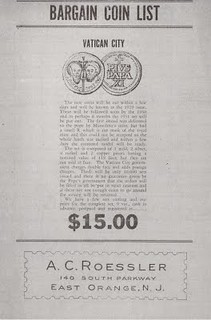 His weekly bargain list for coins was titled The Coin News which grew out of his original Coin List offering coins at highly
competitive bargain prices. One aspect of Roessler's coin business that will prove to be noteworthy to numismatists was his advertising and
promoting medals and commemorative coins and his illustrated cacheted covers of them that popularized them to a new generation of collectors.
His weekly bargain list for coins was titled The Coin News which grew out of his original Coin List offering coins at highly
competitive bargain prices. One aspect of Roessler's coin business that will prove to be noteworthy to numismatists was his advertising and
promoting medals and commemorative coins and his illustrated cacheted covers of them that popularized them to a new generation of collectors.
Commemorative coins were not exclusive to centennial, bicentennial and tricentennial celebrations since stamps were also issued and Roessler pioneered and innovated the cacheted first day cover concept to stimulate collectors to collect both the stamps, covers, and coins and medals that accompanied them in their issues. For the medal and commemorative collector, scholar and dealer Roessler played an important role in helping to establish a stronger market for this specialized niche.
He owned a stamp and coin shop in the Ampere section of East Orange, New Jersey. The shop was taken over by Frank Gerardo Spadone (1924-2000).
He was born in Newark New Jersey on April 7, 1883, son of Austrian-German ancestry of both parents, Albert Roessler, Sr. (1859-1890), a native of New Jersey, and Emma Katherine Erb (1858-), a native of Connecticut. The family name in German is spelled Rössler. His paternal grandfather was Johann Rössler a native of Vienna, Austria, and his wife Mathilda a native of Baden-Württemberg, Germany.
According to the U.S. Census 1900 his mother remarried in 1893 after the death of his father to John Mulcahey. They lived on Mt. Prospect Street, Newark, New Jersey. He became hooked on stamps and coins at the age of ten, and later on specialized as a First Day Cover (FDC) cachet maker and servicer for most of his entire career.
He was a talented artist illustrator and cartoonist and published in Cartoons Magazine. He used his artistic skills to create many illustrations for his three main publications : Roessler's Stamp News, Stamp Dealers News, and Air Plane Stamp News, as well as a myriad of illustrated cacheted first and second day covers.
While living with his parents at 140 South [now called the Oraton] Parkway, East Orange N. J., he moved to Colorado as a young man, first working in the mines and on a ranch. (Newton, 1977, p. 99).
While in Denver he ran a mail order stamp business, and wrote columns and advertised his bargain stamp products in The Stamp Journal of Denver and Philatelic West.
The May 1908 issue of The Stamp Journal in Denver announced that Roessler was leaving his job as President of The Stamp Journal Co., and transferring his stock in the company, to return to full-time residence in New York City.
He applied to the ANA in September and joined the ANA in November 1909 with an address at 1958 Washington Ave. This is the earliest known numismatic activity of Roessler within the mainstream of American numismatics. From here on we find Roessler involved with the coin business until he retired in 1940.
By 1910 Roessler moved across the river to his native city of Newark, New Jersey,
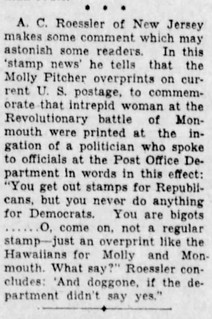
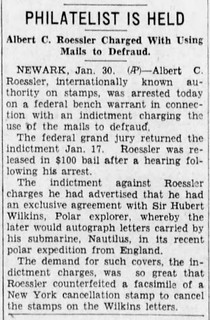
On Jan 1, 1933, Roessler was indicted and arrested on two federal charges of crimes committed five-six years earlier: (1) using the U.S. mails for deceptive purposes in 1927; and (2) printing and using printed items “in similitude of obligations of the United States” in 1928. The first charge was that, while processing event covers for a failed Arctic exploration flight on 9/24/27 by Sir Hubert Wilkins, Roessler faked a facsimile of a New York cancellation to create additional covers after the trip when demand for the covers exceeded the supply actually taken aboard the airplane.
The second charge was that Roessler overprinted “GRAF ZEPPELIN” on a 1c Franklin, and then advertised it for sale at 10c each (Newton, 1977, p. 95) and used it 10/28/28 in combination with other stamps when servicing Graf Zeppelin LZ-127 Flight Covers (See ROE-FZ15, Newton, 1977, p. 95). The overprinting was identical to the font style as the Post Office Dept had used on a 2c Washington stamp for the #646 2c Molly Pitcher and #647/648 2c and 5c Hawaii Issues, which Roessler had previously mocked publicly.
On June 21, 1933 Roessler pled guilty to both charges in Federal Court in Newark. He was sentenced to two years in the Atlanta penitentiary, but the sentence was suspended and he was placed on probation for three years. (Linn’s Stamp Review, July 15, 1933, quoted in Newton, 1977, p. 106).
Roessler appears to have been completely out of business by 1940. Barry Newton suggests that Roessler was near-blind and (citing an article by Stan Fryczynski in May/June 1961 First Days) collected unemployment compensation and welfare benefits from then until his death on January 26, 1952 in Orange, New Jersey. (Newton, 1977, pp. 106-107). However, he may not have been blind but lacked sharp vision adequate enough to draw and carry on his hobby business.
John Lupia adds:
Roessler's cacheted covers are a collecting area for me and I have studied them and him with interest since I grew in his shadows so to speak. The first coin shop I ever visited as a youngster was that formerly owned by Roessler.
Some of the coin and medal inventory of Roessler was still there in the late 1950's and early 1960's of fond memory of this writer, and included ancient and U. S. Colonial coins, among them Fugio, Massachusetts, New Jersey, Connecticut, and New York Cents, as well as Washington pieces, and a variety of American and foreign medals. I remember Spadone talking about Roessler and his arrests and the Federal agents that came into the shop and seized everything.
To read the complete article, see:
ROESSLER, ALBERT CHARLES
(https://sites.google.com/a/numismaticmall.com/www/numismaticmall-com/roessler-albert-charles)
To read the earlier E-Sylum article, see:
THE COIN NEWS (www.coinbooks.org/esylum_v19n30a10.html)
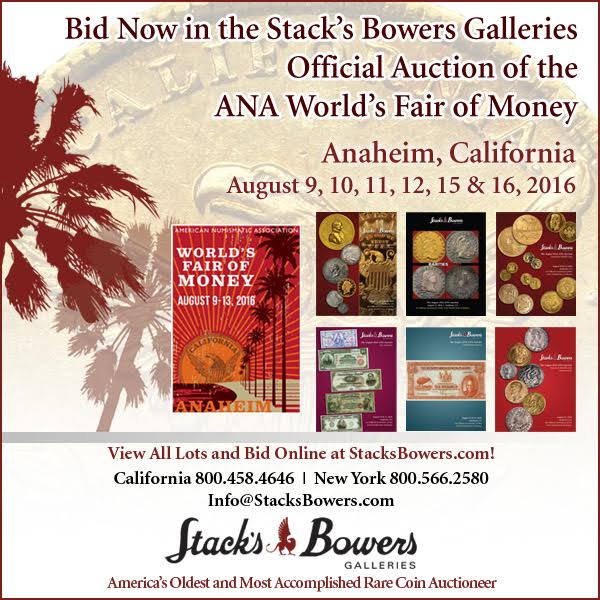
BUILDING THE LILLY COLLECTION, CONTINUED
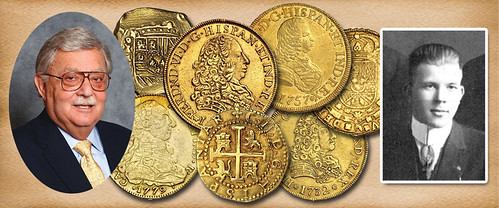
In the last few months of 1953 and into the first half of 1954 there was much excitement and planning in the numismatic hobby. This was because the collection of King Farouk of Egypt was being cataloged to be sold in Cairo in the spring of 1954. At Stack's we were very busy preparing the Anderson-Dupont and Davis Graves catalogs for our pending auctions. All this kept the numismatic press busy, and public interest in the sales in Cairo, and our in New York was very high as a result of much new material on the market.
In early spring 1954, Josiah K Lilly made one of his semi-annual stops in New York and as was customary, he stopped in to visit at Stack's. He inquired what was happening with the coins in Cairo, and what new things had we uncovered to add to his collection. He was happy to examine the Schermerhorn Collection of Double Eagles, ($20 gold). He liked the overall quality and noticed that a few were still missing. We informed him that we were seeking the others, which were primarily in the Saint-Gaudens series.
We discussed how the banks in Europe had many U.S. $20 gold still buried in their vaults, and spoke of our concern that many previous rare dates might be part of these hoards. We advised Mr. Lilly, as we did other collectors, that they should not jump to buy these "rarer dates," as it was possible that a quantity could suddenly appear on the market. Mr. Lilly agreed. We billed him for the Schermerhorn Collection, and he said he would be patient.
Next we reviewed the foreign gold coins we had assembled. But we weren’t done! Mr. Lilly asked, “Since I am now adding the U.S. double eagles to my gold coin collection, what about the other denominations?" We spent an hour explaining the other denominations and he expressed interest in expanding his United States gold collection.
"I would prefer if you could find some of the other U.S. coin series, as partial sets or even complete denominations, as you did years ago with Louis Eliasberg, King Farouk, and others we talked about. I could get a good head start, as I know that there are some sets of these in existence. Is it possible?" Mr. Lilly asked.
Earlier we had spoken about our good fortune in getting for outright purchase, the coins in the Davis-Graves and Anderson Dupont collections. We had told Mr. Lilly how those two acquisitions had precluded our attendance at the Cairo sale.
We then showed him the sets of gold coins from the Anderson-Dupont collection that we were in the process of cataloging for a fall auction. From that collection, we had four (4) different complete sets of lower denomination U.S. gold coins. Each set was housed in beautiful leather boxes, lined with deep purple velvet, as they were when we bought the collection. Each coin from each issue and mint were systematically stored side by side; just opening the boxes was a dazzling experience. !!!
The cases contained:
- A complete set of gold dollars, 1849 to 1889, all dates and mints, primarily in brilliant Uncirculated or Proof.
- A complete set of quarter eagles, 1796 to 1929, all dates and mints primarily in brilliant Uncirculated or Proof.
- A complete set of $3 gold pieces, all dates and mints (no 1870-S), primarily in brilliant Uncirculated or Proof.
- A complete set of $4 gold Stellas, including the 1879 and 1880 Flowing Hair and Coiled Hair, all four in superb Proof.
Looking at the sets, examining them carefully was like seeing the "crown jewels of numismatics." Mr. Lilly was pleased with what he saw, it would meet his needs not to have to try to assemble these beautiful, rare and popular series at one time. Of course he inquired, "How much for the four sets?" We responded " $ 50,000." He looked up at us with a twinkle in his eye and said, "I will take them." For those who want to consider the deal he got, prices were far lower in the 1950s, and many of the coins he acquired would now be five, six, or seven figure coins on the 2016 coin market. My, how coins have grown in value.
After this transaction was completed, Mr. Lilly asked: "Now that I own the $1, $2.50, $3, $4 and almost a full set of $20, how do I gather the $5 and $10 gold sets?” We told him the story of our purchase of the Col. E.H.R. Green Collection from the Chase Bank in 1943-1944 and the $5 and $10 gold coins it contained. From this vast hoard we were able to make virtually complete sets of these denominations that we sold to King Farouk at the time. We also were able to assemble virtually complete sets of $5 and $10 gold coins for Clifford T. Weihman, (who was considered “the olive oil king”) and who still had his coins.
Mr. Lilly, with a smile on his face said " Well maybe he has some left for me!" We all laughed and told him that we would investigate. He thanked us for our help in achieving his goals from when he first walked into our shop to talk about “Pirate Gold.” He also expressed his gratitude for our assistance and expertise as he expanded his collection into other series. To get such a compliment from such a dedicated collector warms my heart to this day.
We arranged for a delivery and set a date in May to hand carry his coins to him and to visit "Eagle’s Nest" again.
To read the complete article, see:
Building a World Class Numismatic Gold Coin Collection: The
Josiah K. Lilly Collection Part 6 (www.stacksbowers.com/News/Pages/Blogs.aspx?ArticleID=2190)
To read the earlier E-SYlum articles, see:
BUILDING THE JOSIAH K. LILLY COLLECTION
(www.coinbooks.org/esylum_v19n23a15.html)
BUILDING THE LILLY COLLECTION, CONTINUED
(www.coinbooks.org/esylum_v19n27a13.html)
THE WILLIAM WOART TOKEN
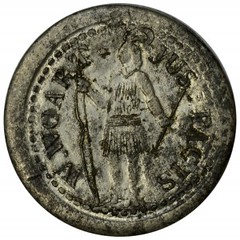
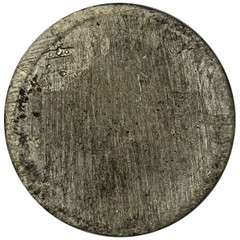
The William Woart token has been a mysterious early American token since it was first announced and pictured in the Colonial Newsletter in 1985 (CNL 10/85 Page 915). When first published thirty years ago, very little historical information was known about this rare item and of the man himself, William Woart. A colonial collector notices the similar design to the Massachusetts copper coinage engraved by Jacob Perkins of Newburyport or Joseph Callender of Boston.
More detailed background information on William Woart has been compiled since the 1985 CNL article, some of which is listed in the Standard Catalog of United States Tokens by Rulau. William Woart moved to Newburyport, Massachusetts sometime before the birth of his daughter, Mary, on March 9th 1801. William Woart is listed in many Almanac references as being a notary public as well as the Justice of the Peace (beginning circa 1805) in Newburyport until 1830 or later.
The token itself, listed as Rulau Mass 90, is an interesting piece. It is a uniface design with the obverse portraying a very similar Indian design to the Massachusetts coinage of the late 1780s. The legends read, W. Woart Jus Pacis. Jus Pacis is translated in Rulau as Justice and Peace, but research has shown that a better translation would be “Justice of the Peace”.
Clearly this was an item designed for William Woart, but the next logical questions are by whom, why and when? Jacob Perkins was an die engraver, inventor and businessman in Newburyport, MA until departing for England in 1818. Based on his engraving of Massachusetts coinage, one might attribute this work to Perkins. Of course, this is just speculation at this point.
The next question is why was this made? A uniface token with the legend William Woart, Justice of the Peace with part of the Massachusetts state seal might have been a business card. As an active Mason, both in Boston and Newburyport, he may have distributed these in his Masonic Lodge. It is possible that William Woart used his judicial wax seal to produce these tin tokens. A document showing his judicial seal might prove this theory, but they have been difficult to locate. A fire (circa 1811) in Newburyport destroyed many town records.
Finally, when was this rare item made? Could it be a modern counterfeit made to deceive the collector? This was an unknown item before 1985; however recent research has turned up a very interesting reference. In a famous 1863 Woodward Sale (April 28th, 29th, 30th and May 1st 1863), lot number 1800 is described as Woart, W. Jus Pacis. Indian standing, reverse plain, very rare. Clearly, it is not a modern fake. If Perkins was the engraver, one could date the Newburyport business card to the 1805 to 1818 period.
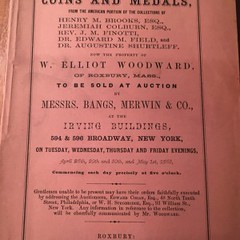
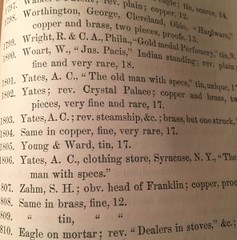
Like many pieces of Exonumia, the William Woart token still has some mysteries to unravel, but it is a wonderful piece of early Massachusetts history. There are two (or possibly three including the Woodward auction) known, including the example shown above in the NER Collection.
In today’s internet age, so many historical books and documents are right at our fingertips. Without those resources, almost everything known about this token would come from visiting libraries and historical societies. Researching items like this is what makes collecting Exonumia so much fun and rewarding.
To read the complete article, see:
The William Woart Token
(http://nerarities.com/2016/03/17/the-william-woart-token/)
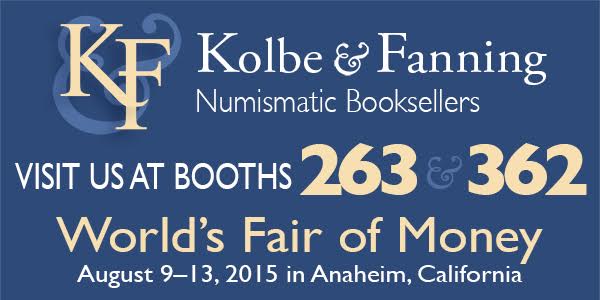
THE J.B. SCHILLER NEW ORLEANS COUNTERSTAMP

Counterstamped 1860 Indian Head Cent with “J.B.SCHILLER” across obverse, and an ‘X’ on the reverse, suggesting that the coin was intended to pass for ten cents. Considered quite rare as only a dozen or so specimens are presently known. This piece is frequently referred to as a “Siege Token” although I can’t imagine why. At no point in the campaign was New Orleans ever even surrounded, much less under siege!
John B. Schiller owned Sazerac House, a saloon at 116 Royal Street in New Orleans. He imported spirits, including Sazerac (a French cognac). Schiller also created a cocktail called the “Sazerac” which helped make New Orleans famous.
For many years, including 1860, all the one-cent coins were struck at the Philadelphia Mint. Louisiana passed her Ordinance of Secession on January 26th, 1861, so it seems unlikely that any 1861 cents would have been shipped to New Orleans. With the hoarding of hard coinage brought on by the War, Schiller acquired a quantity of 1860 one cent coins and had them counterstamped to make change at Sazerac House.
By early 1862, the coin shortage was so acute that Schiller apparently felt the need to have 25- and 50 cent scrip notes prepared. They were printed on white paper in black ink, dated April 3rd 1862, and signed “John B. Schiller” with a hand written serial number, both in red ink. Note the address typo “16 ROYAL STREET’ rather than “116”. The notes were also backstamped J.B. SCHILLER in red cork.
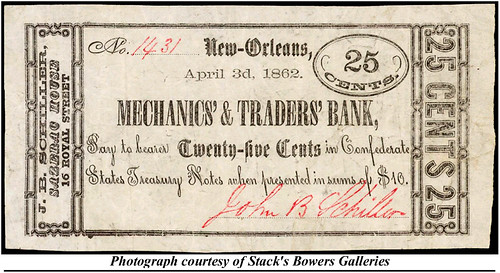
When the USS Brooklyn anchored off the mouth of the Mississippi as a blockader, the citizens of New Orleans still felt quite secure behind their city’s defenses which were anchored at Forts Jackson and St. Philip. These two masonry forts were situated some 60 miles below the city at a bend in the Mississippi River. The defenses also included earth-works above the forts and obstructions in the river below, plus a 12 gun-boat river defense fleet and some 10,000 troops in New Orleans under Genl Mansfield Lovell.
Over the winter of 1861-1862, Union war planners created the Department of the Gulf with the objectives of capturing Mobile, New Orleans, Baton Rouge, and Galveston. Genl Benjamin Butler was given command of the new Department and planners set the first objective as New Orleans, a major port and one of the South’s largest cities. Union forces began operations against the Crescent City on April 8th, 1862. Admiral DD Porter’s 19 Mortar schooners lead the way up the River, followed by Admiral DG Farragut’s 24 war ships.
General Butler followed with some 9,000 troops on transports. On the 17th, under cover of night, the Mortar boats closed on Forts Jackson and St Philip and engaged the old masonry forts from April 18th through the 23rd, firing some 17,000 shells in an effort to destroy the forts’ guns. Despite this massive bombardment, the federals failed to disable the Confederate guns in the forts, but Union gunboats had meanwhile cleared a passage through the downstream obstructions. Admiral Farragut determined to run the gauntlet of the forts with his heavier warships by relying on their greater maneuverability of steam power over sail. Farragut’s heavy fleet ran past Forts Jackson and St Philip at 2:00 in the morning on April 24th. In the darkness a tremendous exchange of fire took place during the passage but the Union fleet got through and continued upstream, where it defeated the Confederate gunboat flotilla. The way to the Crescent City was open.
Panic prevailed in New Orleans as citizens fled with their possessions. All the bullion remaining at the New Orleans Mint and millions in bank funds were shipped out of the city to avoid theft by the Federals. Gen Lovell and his troops evacuated the city as 15,000 cotton bales burned on the levee, consuming several dozen ships in the process. Admiral Farragut approached with nine of his large warships and demanded the city’s surrender under threat of bombardment. So New Orleans surrendered to avoid destruction and Genl Butler arrived on May 1st, landed his troops, and took formal possession of the city.
But civilian life somehow goes on and Schiller’s Sazerac House continued in business. On May 16th, 1862, occupation authorities put Butler’s General Order No. 29 into effect, forcing the city and all banks to cease any and all trading in Confederate Notes and in any obligations payable in Confederate Notes. The effect was to render Schiller’s scrip totally worthless, so it seems that his notes only circulated for some six or seven weeks. But the business continued to prosper and Schiller sold Sazerac House to his chief clerk in 1870.
Sometime after the War, a relative of Schiller’s moved to Canada, taking with him one of the counterstamped coins and one of the 25 cent scrip notes. That coin and note were acquired by a Canadian collector in 1956 who sold them to the Federal Coin Exchange in Cleveland, Ohio. Federal then offered them at auction and they were acquired by noted numismatic scholar Robert J. Lindesmith, who announced their appearance in the TAMS journal (Jan-Mar 1963). Russell Rulau next penned an article about them in Coin World (Feb 1, 1963) and Bill Manning published a short piece in the TAMS Journal (Feb 1978).
To read the earlier E-Sylum articles, see:
CIVIL WAR SIEGE COIN OFFERED (www.coinbooks.org/esylum_v08n47a11.html)
NEW BOOK: CONFEDERATE NUMISMATICA, PART 1
(www.coinbooks.org/esylum_v19n30a04.html)
SELECTIONS FROM PRESIDENTIAL AUCTION 86
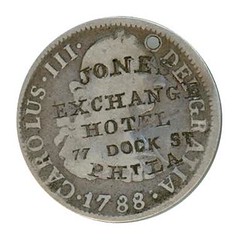 Lot 21: Jones Exchange Hotel Counterstamp
Lot 21: Jones Exchange Hotel Counterstamp
Pa 239F. JONES EXCHANGE HOTEL, PHILADELPHIA. Brunk 21940. A sharp c/s on a holed 1788 2 reales.
Lot 30: Richardson's Battery
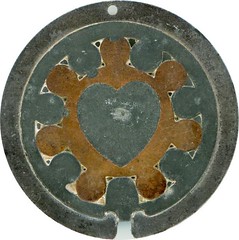
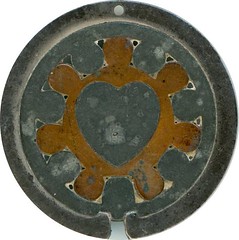
UNLISTED VARIETY OF RICHARDSON'S BATTERY. Type of MAV 117 & Storer 5784 But struck in 52mm. Very Fine. A white metal band surrounds a brass ring encasing copper, lead & brass discs surrounding a lead heart at center. The obverse of the heart bears an incused inscription: MAGNETO GALVANIC around RICHARDSON’S/ BATTERY. The heart on the reverse is incused with PAT. IN U.S. A. FEB. 9, 1881, around IN CANADA/ FEB.9/ 1881.
The Richardson, Boyd and other similar Galvanic Batteries supposedly worked by "galvanic action" due to the "union of metals." Whereas in a common battery the effect is facilitated by an acid, These device needed only "the natural humidity of the skin" to cause a beneficial flow of electricity. This was sufficient to cure nearly any disease by producing "a proper proportion of electricity" in the blood—or so "Professor" Boyd claimed. The Boyd Battery is the most common of the type. The Richardson batteries are all rare and this unlisted variation is the first that has come to our attention. It is not mentioned in this size by either Storer or Rulau.
Lot 33: Henry Cook Store Card
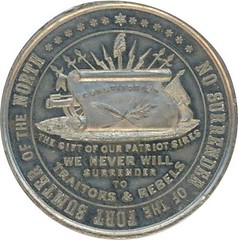
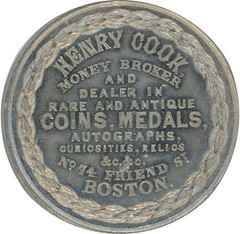
115-Aa-1e. HENRY COOK, BOSTON, Rulau MaBo 19A. 42mm. White Metal. George Lovett, Sc. Brilliant Proof-like Unc. with a small dig above the R in FRIEND on the reverse. This is a wonderful political store care issued by Bostonian Henry Cook, who, among a variety of pursuits, was among the first to advertise himself as a dealer in coins and medals. At obverse center is a scroll labeled CONSTITUTION and below, THE GIFT OF OUR PATRIOT SIRES/ WE WILL NEVER/ SURRENDER/ TO/ TRAITORS & REBELS. Within a band around the rim is 13 starts and the legend, NO SURRENDER OF THE FORT SUMTER OF THE NORTH
Lot 49: Philadelphia Fire Department Grand Parade Medal
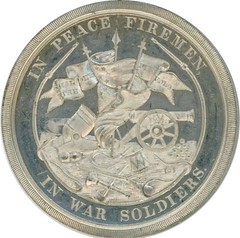
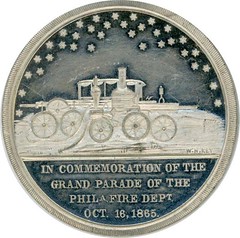
GRAND PARADE OF THE PHILADELPHIA FIRE DEPARTMENT, 1865. Marqusee 214. 51mm. White Metal W.H. Key, Sc. Choice Unc. Obv: An early horse-drawn fire engine under a canopy of stars. In exergue: IN COMMEMORATION OF THE/ GRAND PARADE OF THE/ PHILA. FIRE DEPT./ OCT. 16, 1865. Rx: IN PEACE FIREMEN IN WAR SOLDIERS around a montage of banners, flags, cannon, rifles, etc.
The Parade was a sight to behold. Over one hundred companies were in the procession. More than twenty thousand firemen marched in the parade which stretched for over 20 miles. The newspapers of the day noted with approval (and some surprise?) that there was not "a single scene of disorder." White metal specimens were used as parade badges and are most often found holed. This unholed specimen is unusual.
Lot 65: Goetz 'With Hindenburg For Germany' Medal
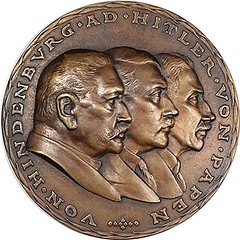
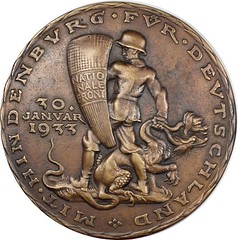
WITH HINDENBURG FOR GERMANY, 1933. C-31; K-484. 139.6mm. Cast Bronze. Karl Goetz, Sc. About Uncirculated. Obverse with busts of Hindenburg, Hitler and Von Papen to the right, their names around. The reverse displays a German soldier holding a shield inscribed "National Front", while slaying a dragon. (No swastika on shield) . Dated "Jan. 30, 1933" to left. The legend translates as "With Hindenburg for Germany".
This massive medal commemorates President Hindenburg nominating Hitler as chancellor and von Papen as vice-chancellor in early 1933. Even though Von Papen’s title was vice chancellor, at this stage of development, he still held the political power. Eight of the cabinet members were allied with him as opposed to only three with Hitler and it was Von Papen, not Hitler, who had the ties to Hindenburg.
Goetz submitted this medal to the Brown House, the Nazi Part headquarters for all of Germany for approval, but after a long wait approval was denied as the reverse did not display a swastika and Goetz was not a party member. A later, edited design was made with a swastika on the shield that was approved and struck in 60mm. and 36mm sizes. This is an early, rare piece before the design was changed. Its absence in the 2006 auction of the 1700+ lot Bottcher collection of Goetz medals attests to its rarity. An important and imposing medal which catalogs Hitler’s path to power.
Lot 144: Thomas Elder Portrait Medal
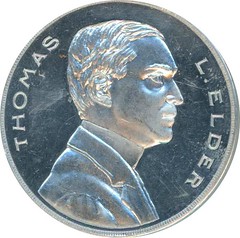
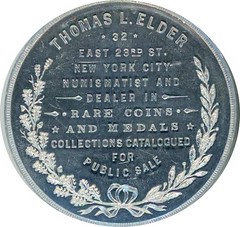
THOMAS ELDER PORTRAIT MEDAL, 1908. DeLorey 1. 51mm. Aluminum. Choice PL Brilliant Uncirculated with light hairlines. Obverse: Bust to the right, THOMAS L. ELDER to either side. Reverse: THOMAS L. ELDER/ 32. EAST 23RD ST./ NEW YORK CITY/ NUMISMATIST AND/ DEALER IN. RARE COINS/ AND MEDALS/ COLLECTIONS CATALOGUED/ FOR/ PUBLIC SALE.
This medal is pictured on page 126 of the first edition of H&K’s book on So-Called Dollars above his biography
Lot 181: 1860 Henry Clay Medal
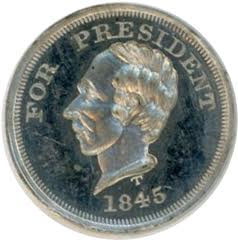
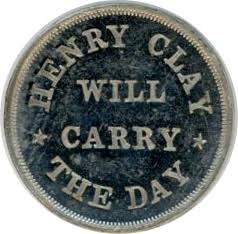
HENRY CLAY WILL CARRY THE DAY, CA. 1860. HC-D. 19.5mm. WM. Choice PL Unc. A beautiful premium condition piece. Obv: FOR PRESIDENT above a bust of Clay to the left. 1845 at bottom. Below the bust is the designer’s initial, “T”. Rx: HENRY CLAY/ WILL/CARRY/ THE DAY. A star to right and to left.
Elder attributed the obverse die to Benjamin True while DeWitt thought it was executed by Joseph Thomas. We agree with DeWitt. Scarce.
Lot 312: 1968 Assay Medal
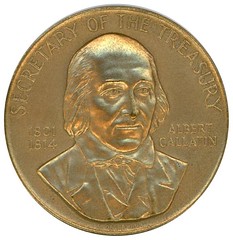
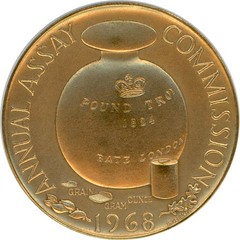
1968 ASSAY MEDAL. JK-AC-112. 57.4mm. Bronze. Frank Gasparro (Obv.) & Edgar Z. Steever (Rev.), Sc. Uncirculated, without the heavy speckled tarnish which often plagues these late date assay medals. Housed in its original US Mint presentation box. The obverse presents a facing bust of former Secretary of the Treasury (1801-1814) Albert Gallatin while the revere displays a large weight inscribed: POUND TROY 1824 BATE LONDON. At bottom are smaller weights marked GRAIN, GRAM and OUNCE.
According to the author of the OTACS pamphlet, a mere 45 of these medals were struck by the Mint. Our last offering of one of these medals was in our 2010 Auction Eighty where an Uncirculated specimen brought $2415.00. The previous owner's note accompanying this lot states that it was purchased from our 1986 Dreyfuss Collection Sale for $770.00. (No lot envelope).
Lot 410: Isaac Greenwood ANS Membership Medal
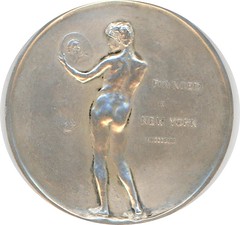
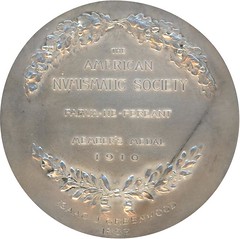
AMERICAN NUMISMATIC SOCIETY SECOND MEMBERSHIP MEDAL – SPECIAL PRESENTATION MEDAL , (1911) Miller 27; Baxter 248; Marqusee 54. 77mm. Silver. Gutzon Borglum, Sc. (Tiffany & Co.). About Uncirculated with a thin streak of tarnish on the reverse, as shown. Obverse with a backside view of a nude male figure looking at a portrait plaque. FOUNDED/ IN/ NEW YORK/ MDCCCLVIII. The reverse bears the inscription: THE/ AMERICAN/ NUMISMATIC SOCIETY /PARVA NE PEREANT/ MEMBER’S MEDAL/ 1910 with a wreath above and below. At bottom is engraved the member’s name, ISAAC J. GREENWOOD/ 1859.
This particular medal is mentioned by Miller on p. 84. "Silver membership medal have also been presented on occasion, such as that presented to Isaac Greenwood shortly before his death in 1911. He was, at the time, the Society's oldest member, and that was the reason for the presentation. Greenwood joined the society in 1859 and served as Second Vice President from July 28, 1864, until March 22, 1866. Also in 1911, Greenwood gave the Society his collection of more than 3,000 coins, medals and banknotes, as well as his numismatic book.
To access the online catalog, see:
http://www.maineantiquedigest.com/launch/shows_and_auctions/1762/description?iframe=true
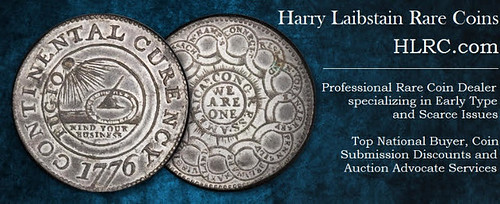
THE CLOISTERS ACQUIRES RARE LATE MEDIEVAL MEDAL
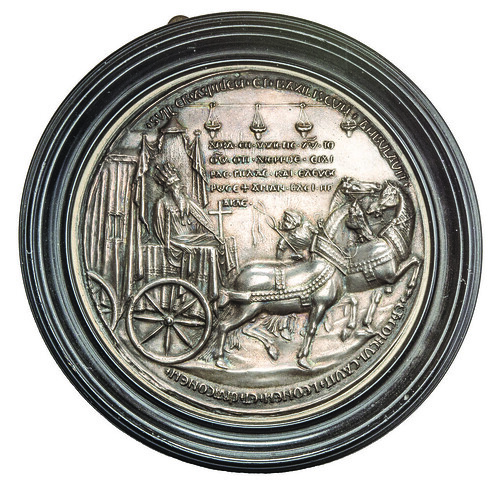
Renaissance and Baroque medals from the collection of Sir Timothy Clifford, former director of the Scottish National Gallery, sold for £82,872 ($117,844) in a specialised sale of coins and medals at Morton & Eden in London (June 13, 2016).
The highlight from Sir Timothy’s collection was an extremely rare French silver repoussé impression of a gold medal that formerly belonged to the important early renaissance collector Jean Duc de Berry (1340-1416). Depicting The Emperor Heraclius’s Return of the True Cross to Jerusalem the image became the inspiration for one of the illuminations in the famous book of hours known as the Belles Heures, itself commissioned by the Duc de Berry around 1409 and which is in the possession of The Cloisters Museum, part of the Metropolitan Museum of Art in New York which specialises in European medieval art.
The Belles Heures has been described as one of the most celebrated manuscripts of the Middle Ages with fine illuminations attributed to the Limbourg brothers working in France in the early 15 th century.
Estimated at up to £10,000 there was considerable interest shown and The Cloisters was able to acquire the medal for £21,600 ($30,715) against strong competition.
Tom Eden, a director of Morton & Eden commented: “We were very pleased that this intriguing medal has found a new home in The Cloisters Museum as it very much complements the illuminated manuscript, the famous Belles Heures which already resides there. In many ways it is the ideal place for it”.
School of Paris, Heraclius, Byzantine Emperor (610-641), The Return of the True Cross to Jerusalem, silver repoussé impression after the famous gold medal once in the possession of Jean, Duc de Berry (1340-1416), Heraclius in a covered triumphal car drawn by three horses, holding the True Cross; at the far side of the horses is a diminutive figure holding a whip and turning back towards the emperor; four lamps hang from a rail above them; Latin and Greek inscriptions above and below and in five lines across field, 102mm and 97mm excluding the outer rim (Jones, BMC, 5-7, especially 6 (e) for the silver double-sided repoussé piece in Paris illustrated by Babelon, La Médaille et Les Médailleurs, 1927, pl. III; Arm. II, 8, 6; Kress 525 = Pollard II, 598; Scher in Currency of Fame, pp. 32-37; Syson & Gordon, Pisanello, 20, 3.29), an extremely fine image, small French import mark of “cygne” near top edge and small section of outer order missing at 12 o’clock, extremely rare as a silver repoussé version, thought to be the earliest type of copy made after the no-longer-existing original in the Duc de Berry’s collection [Clifford lot 422, see also inside front cover illustration including frame] £5,000-10,000
The following note borrows in part from the footnote written in the 1996 Clifford sale catalogue. Of the two large gold medals of Constantine and Heraclius recorded in the inventory of the collections of Jean Duc de Berry, the Constantine medal was purchased from a Florentine merchant Antonio Mancini on 2 November 1402 and it has generally been assumed that the Heraclius medal came from the same source. It is from these two pieces or indeed copies of them that were commissioned by the Duke himself that all later versions seem to be derived. The earliest known versions consist of silver repoussé plates joined at their rims (for which see Jones, BMC, 1 and 6 – and the present piece). The solid casts mainly in bronze are thought to be later. The original of the Heraclius medal was in gold and was evidently in the French Royal cabinet, stolen and melted down in 1831 (see Jones, BMC, I, p. 26, note 15).
The original medals probably date from 1400-1402 when Manuel II Palaeologus visited Paris since the legends on both medals show a knowledge of the Byzantine chancery formulae in use at the time. Also the features of the emperors on both medals do not conform to the traditional iconography of either Constantine or Heraclius, but rather show a marked similarity to Manuel II himself (for portraits of Manuel II see Bibliothèque Nationale, Paris, MS Suppl. Gr. 309; Herrin, J, Byzantium,The Surprising Life of a Medieval Empire, London, 2008, fig. 40). The medals were almost certainly produced in Paris, possibly with the Duke in mind as a purchaser. It may not be a coincidence that in March 1402 the Duke purchased two other “antique” medals of Augustus and Tiberius, from another Florentine merchant established in Paris, Michele de’ Pazzi. It has been suggested that they may be the work of the Parisian artist Michelet Saulmon, who is mentioned as the maker of a gold jewel in the Duke’s final inventory of 1416.
To view the Morton & Eden catalogue, see: www.mortonandeden.com/pdfcats/80web.pdf
For more information on The Cloisters, see:
http://www.metmuseum.org/visit/met-cloisters

CARNEGIE HERO MEDAL WINNER'S GRAVE TO GET PLAQUE
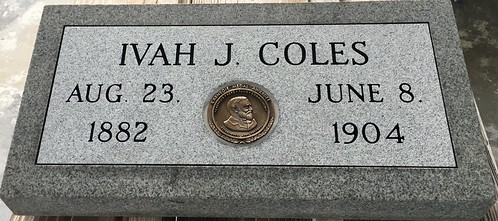
It was a typical June evening when Ivah Coles, age 21, and Richard Cromwell, age 20, went for a swim in the reservoir near Benld. While attempting to climb up the steep, high bank, Cromwell fell back into the water and began to sink. From the bank, Coles waded into the water toward Cromwell but sank within eight feet of him. The men’s bodies were found in water 10 to 12 feet deep; the reports indicated that they were victims of cramps, caused by the chilliness of the water due to springs nearby. That was June 8, 1904.
Though newspaper accounts of the incident gave no stirring account of bravery or heroism on Coles’ part, recognition would come later. In 1908, Coles’ mother was presented with a silver Carnegie Hero Medal, Coles’ act being among the first few dozen recognized by the Carnegie Hero Fund Commission (CHFC), which since 1904 has recognized nearly 10,000 acts of heroism throughout the United States and Canada.
The Coles medal was recently put up for sale on eBay by a jeweler in O’Fallon, Mo., who had acquired it from someone selling it for its 5 1⁄2 ounces of silver. The medal was purchased by Matthew Campbell, a member of the Pennsylvania Association of Numismatists (PAN), of Washington, Pa., who contacted the Commission, based nearby in Pittsburgh. Rarely seen for sale, these medals are usually held by the recipients and families and heirlooms. Additionally, of the nearly 10,000 Carnegie medals, only 617 are silver; most were bronze.
When Campbell contacted the Macoupin County Historical Society (MCHS) for research assistance, the society seized on the story, gathering information and locating Coles’ grave at Bunker Hill Cemetery. Finding Coles’ grave site to be unmarked, Campbell, PAN, MCHS, and various individuals contributed funds to install a memorial plaque and a Carnegie Hero grave marker supplied by CHFC. The plaque will be installed at Bunker Hill Cemetery during a ceremony at 11am on Wednesday, August 24.
“Knowing what this medal represented and that it was given to Coles’ mother was very special,” said Campbell, who will travel the 550 miles to Illinois for the ceremony. “That motivated me and all of us at PAN to support the plaque at Coles’ grave and create an exhibit. It’s a tribute to numismatics that an object purchased on eBay brought all of us together for this project 112 years later.”
The Coles medal, which traveled from O’Fallon to Pennsylvania, will return to Illinois to be exhibited at MCHS’s Ruyle Building at a reception. A photographic display will remain at MCHS, while the medal will be displayed at PAN’s semiannual conventions in Pittsburgh and potentially travel nationally for other events.
“We were impressed with the work done by Campbell and the Pennsylvania Association of Numismatists,” said Eric P. Zahren, Executive Director of CHFC, who will also attend the events in Illinois. “We were happy to support this project to honor Coles and make his inspiring story known to the community.
Matt Campbell adds:
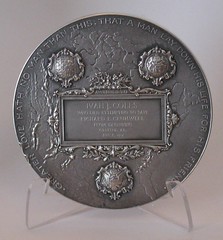 Some new snippet of information comes to light every day. For instance, the medal say Coles died trying to save "Richard
Crumwell". The medal has the name misspelled - it's actually Cromwell, but evidently the family spoke in such a manner that it sounded like
"Crummel."
Some new snippet of information comes to light every day. For instance, the medal say Coles died trying to save "Richard
Crumwell". The medal has the name misspelled - it's actually Cromwell, but evidently the family spoke in such a manner that it sounded like
"Crummel."
The society also found newspaper accounts from 1904 and a death certificate for Coles. We identified the reservoir where the two men drowned, and someone ran out and snapped a picture.
In addition to Ivah Coles, Macoupin County has three other Carnegie medal recipients (from the 1920 and 1930s). We hope to have relatives attend the August ceremonies, and I will try to arrange to get a photo of all the Carnegie medals on one table.
The Observer-Reporter, our local newspaper in Washington, PA, did a nice story.
There's also a podcast that came out yesterday with Dave Jokisch from the historical society on WSMI radio in Illinois.
To read the Observer-Reporter article, see:
Hero’s grave will be anonymous no more
(www.observer-reporter.com/20160722/herox2019s_grave_will_be_anonymous_no_more_)
To listen to the Historical Society podcast, see:
Forum "Ivah Coles to be Honored"
(http://wsmiradio.com/wire_new/podcasts-forum/2016/03158_FORUM_7-30-16_061420.php)
To read the earlier E-Sylum article, see:
SILVER 1904 CARNEGIE HERO MEDAL SOLD
(www.coinbooks.org/esylum_v19n25a23.html)
ON SHIPWRECK SALVAGE
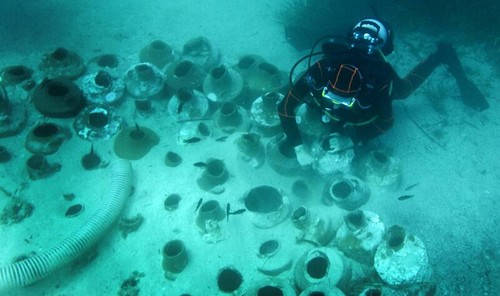
Ancient Roman amphorae off the coast of the Southern France
Unesco estimates that there are some three million shipwrecks scattered across the ocean floor. This means there is a vast trove of archaeological material awaiting discovery, all of it, fortunately, safe from destruction or theft by the criminal factions now operating on land.
The technology needed for deep-sea exploration is advancing rapidly. What once seemed like science fiction will soon become a reality, with exploratory probes not only transmitting images but operating retrieval devices equipped to reveal artifacts and move them to the surface. Archaeologists have also begun using DNA analysis on wrecks in the Mediterranean, yielding information ranging from what onboard bowls once contained to the home port of the sunken ship.
But only a tiny fraction of this material has been explored. For example, of the Archaeological Institute of America’s Fieldwork Opportunities Bulletin listings in Italy, only three involve underwater archaeology. And this in the nation estimated to have among the highest concentrations of archaeological sites in the world.
If discovered relatively undisturbed, shipwrecks offer a tantalizing opportunity for archaeologists. They can yield remarkably detailed information about both the cargo and the presumed origins and destination of the vessel. They can also provide extraordinary insight into the geopolitics, economies and artistic inclinations of any given period of the ancient world. Archaeologists follow a rigorous set of procedures not just to retrieve objects but to preserve whatever information about them the site itself can disclose.
In recent decades, a cottage industry of private exploration companies has emerged, lured by the promise of gold bullion and coins known to be in wrecks of trading vessels from the 16th century onward. Many of these are clustered along the eastern coastlines of North and South America. Such expeditions are rarer in bodies of water frequented in antiquity owing to our lack of information about lost treasure. But given the rate of progress in detecting and evaluating the contents of sunken vessels, we will doubtless soon see an increase in the pursuit of ancient shipwrecks.
While the intentional looting and destruction of land-based sites is in the headlines today, another looming challenge to those seeking to safeguard the past awaits us underwater. And a fresh look at international accords governing the Law of the Sea as well as national laws is urgently needed.
To read the complete article, see:
Cultural Heritage’s Nautical Future
(www.wsj.com/articles/cultural-heritages-nautical-future-1468273487)
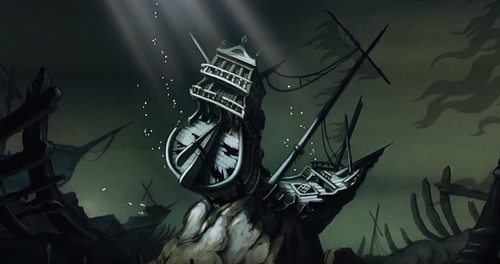
A Hollywood Shipwreck: The Little Mermaid
If I were asked to picture a shipwreck, a clear image would pop into my mind. I’ve never seen a shipwreck in real life; most of us haven’t. My imaginary shipwreck has a very clear source, though, one that was influential on my young mind. I'm imagining the shipwreck from Disney's The Little Mermaid.
For me, the shipwreck that Ariel explores was iconic. But, if this is the vessel that defines shipwreck for me, how much of my idea of a sunken ship is pure Disney magic? Is there any truth to it?
Kevin Crisman, the director of the Center for Maritime Archaeology and Conservation at Texas A&M University, immediately knew the genre of ship I was talking about: maritime archaeologists joke about “Hollywood shipwrecks” all the time, he says. One of the shipwrecks they “love to hate to watch" is the 18th-century ship that Nicolas Cage finds frozen in Arctic ice, at the beginning of National Treasure. (It’s very shortly blown to pieces with centuries-old gunpowder.)
The Little Mermaid shipwreck was not one he had considered closely before, but Crisman graciously agreed to watch a few clips from the movie and give me his professional opinion about the wreck where Ariel famously finds a dinglehopper (also known as a fork). Now that I write about real shipwrecks, I wanted to know: What type of ship were we looking at? What made internal sense? And what was total fantasy?
To read the complete article, see:
I Made a
Shipwreck Expert Watch The Little Mermaid And Judge Its Nautical Merits
(www.atlasobscura.com/articles/i-made-a-shipwreck-expert-watch-the-little-mermaid-and-judge-its-nautical-merits)
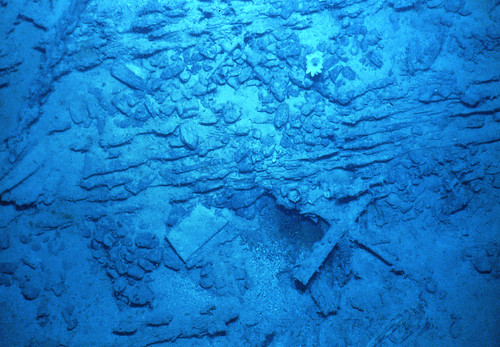
A Real Shipwreck
Bob Evans writes:
I am quite familiar with Hollywood Shipwrecks, or Hollywood Treasures. Attached is a photo of a real shipwreck. It wouldn't play on the big screen. Incredible states of preservation are typical of Hollywood Shipwrecks, as are grievous anachronisms, as pointed out in the article.
I would point out that the interviewee can't help himself in getting in a dig about leaving artifacts for future archaeologists. "In situ preservation" is a myth, and a political agenda for some archaeologists. Some objects will survive, and I am not in favor of haphazard destruction of scientific information. But artifacts on shipwrecks, and the important information they hold, are in a constant state of marine peril, degrading even as I write this. They will be lost for all time if not properly excavated, conserved, and studied. Sooner is often better than later, though salvage probably should not be conducted by Hollywood mermaids.

COIN HOARD FROM THE TIME OF EMPEROR CONSTANTINE
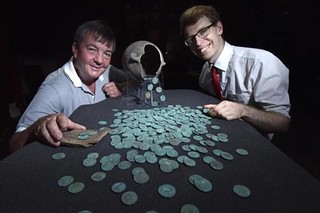 A metal detectorist from Hartlepool has told of his “find of a lifetime” after discovering the largest ever hoard of Roman coins found in
the north of England.
A metal detectorist from Hartlepool has told of his “find of a lifetime” after discovering the largest ever hoard of Roman coins found in
the north of England.
David Blakey, 57, found a ceramic pot containing more than 1,800 Roman coins dating back to the year 370 AD in a farmer’s field near Scarborough in September 2014.
The discovery has been made public for the first time as the Yorkshire Museum, in York, has launched an appeal to raise £44,200 to keep the hoard in Yorkshire and on public display.
David, who lives in the Clavering area of the town, said: “It is the find of a lifetime – the find of 10 lifetimes.”
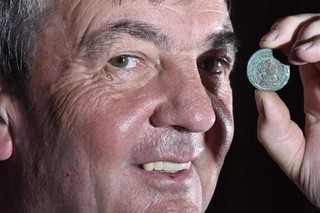 The semi-retired lab technician was scanning for treasure with the Dunelm Metal Detector Club near the village of Wold Newton, East
Yorkshire.
The semi-retired lab technician was scanning for treasure with the Dunelm Metal Detector Club near the village of Wold Newton, East
Yorkshire.
The club had visited the area for the last six years and found the odd Roman coin and medieval find.
Archeologists say the hoard is particularly significant as it sheds light on a pivotal period in York’s history and the western world.
The coins depict several co-emperors who were all jockeying for position. When York’s ruler Constantius died his son Constantine became the first Christian emperor.
Andrew Woods, of Yorkshire Museum, said: “This is an absolutely stunning find with a strong connection to one of the most significant periods in York’s Roman history.
“We hope to now save the hoard to make sure it stays in Yorkshire for the public to enjoy but also so we can learn more about this fascinating period as well as why it was buried and to whom it might have belonged.”
To read the complete article, see:
Hartlepool
metal detectorist discovers biggest ever Roman coin hoard in North
(www.hartlepoolmail.co.uk/news/local/hartlepool-metal-detectorist-discovers-biggest-ever-roman-coin-hoard-in-north-1-8036650)
MUSEUM SEEKS FUNDS TO PURCHASE WOLD NEWTON HOARD
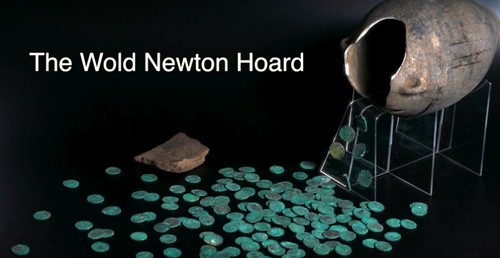
An appeal has been launched to save the largest Roman hoard of its type ever discovered in the north of England. The Hoard of more than 1,800 Roman coins was discovered by a metal detectorist near the village of Wold Newton, East Yorkshire, in 2014.
The hoard dates to 307AD, a period of great uncertainty in the Roman Empire and Yorkshire. It features coins depicting Constantius and also the first coins to proclaim his son, Constantine, Augustus after he was made emperor in York.
The Yorkshire Museum, York, now have four months to raise £44,200 to keep the hoard in Yorkshire and in public collections.
The appeal is launched on July 25 – 1,710 years since the death of Constantius in York and his dying wish that Constantine should be his successor.
Andrew Woods, curator of numismatics at the Yorkshire Museum, said:
“This is an absolutely stunning find with a strong connection to one of the most significant periods in York’s Roman history. No hoard of this size from this period has ever been discovered in the north of England before.
“It contains coins from the time of Constantius who died in the city and then the first to feature Constantine, rising to power. This was a pivotal moment in York’s history but also the history of the western world. It was also a time of great uncertainty in the empire, as different Roman powers looked to challenge Constantine’s claim as emperor.
“We hope to now save the hoard to make sure it stays in Yorkshire for the public to enjoy but also so we can learn more about this fascinating period as well as why it was buried and to whom it might have belonged.”
David Sundman adds:
I hope the Yorkshire museum isn't successful in raising the money, and it goes to collectors. Museums have enough coins to study!
To read the complete article, see:
YORKSHIRE MUSEUM TO RAISE £44,200 TO SAVE THE LARGEST ROMAN HOARD OF ITS TYPE DISCOVERED IN THE NORTH
(www.yorkshiremuseum.org.uk/news-media/latest-news/yorkshire-museum-to-raise-44200-to-save-the-largest-roman-hoard-of-its-type-ever-discovered-in-the-north-of-england/)
THE BOOK BAZARRE
HIGHLIGHTS OF JACQUIER’S AUCTION 42
September 16, 2016 Paul-Francis Jacquier, Kehl am Rhein Auction 41 – Classical Coins and Ancient Art Auction 42 – The Michel Thys Collection “Gallic Empire“ 450 lots featuring coins of the Gallic Empire at Jacquier’s
An unbelievable number of 450 lots featuring coins of the Gallic Empire are on offer at Paul- Francis Jacquier’s auction on September 16, 2016 with a focus on antoniniani and denarii, including all rarities imaginable.
Postumus, Laelianus, Marius, Victorinus, Tetricus I and his son Tetricus II – these were the emperors ruling over the so called “Gallic Empire“, which, during its biggest geographical expansion wasn’t only Gaul, but also comprised Germania, Raetia, Spain and Britain.
Although written records are sparse, numismatic sources are plentiful. And how plentiful the new catalog of the Paul-Francis Jacquier auction house demonstrates: It features the roughly 450 lots of the Michel Thys Collection “Coins of the Gallic Empire”; accompanied by up-to- date scholarly comments.
((Abb. 01 – The collector Michel Thys.))
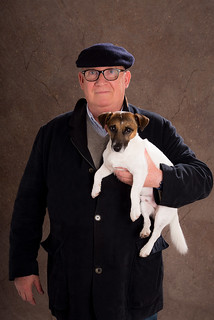 The collector Michel Thys
The collector Michel Thys
Michel Thys has been collecting coins since he was 15. Everything started with a discovery on the attic of his classmate Thierry Baron
d’Orjo de Marchovelette. One of his ancestors had forgotten a group of antoniniani of the 3rd century on the attic of his lavish family
castle near Namur. His descendant sold 4 of them at the moderate price of 20 Belgian francs – in today’s currency about 50 cents – to
Michel Thys, who in turn discovered a passion for life. In the following years he assembled rarities of the Gallic Empire in the best
possible grades. What will go over the auction block at Jacquier’s Auction 42 shows how much knowledge, experience and enthusiasm the
collector invested in his passion.
The main focus of the collection are antoniniani, the main denomination of this era, as well as billon denarii, which normally were struck from the dies of gold coins. Of course there are also sestertii, even though they didn’t receive as much enthusiasm from the collector. What was fascinating to Michel Thys were the many imitations of the local mints, following the model of Roman coins. At the end of the auction numerous of these imitations will be offered at collector friendly estimates.
In general, don’t let the specimens presented in the following mislead you. The auction will offer many lots in the two-digit region. Whoever is interested in coins of the Gallic Empire should not miss out on this auction!
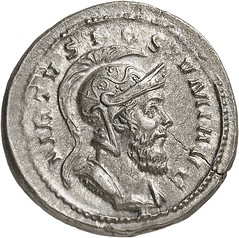
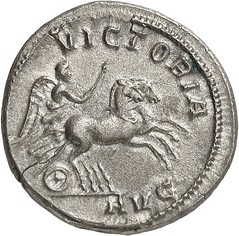
((509 – Postumus. Denarius (billon off-metal strike from an aureus die), Cologne, fall of 261. C. 399 (150 Fr.). Elmer 174 (Aureus). Schulte 11b (this coin). From the Hoffmann Collection, Rollin & Feuardent Auction (1898), 1942. Unique. Extremely fine. Estimate: 8,000 euros))
Postumus There are so many Postumus highlights, it’s hard to decide which ones to mention and which ones to skip. One to definitely mention is a denarius of the fall of 261, minted in Cologne and struck from the dies of the Schulte 11 aureus. On its reverse it shows Victoria riding a biga to the right and cracking the whip. Schulte mentions the specimen, which is now part of the Thys Collection, as 11b (estimate: 8,000 euros).
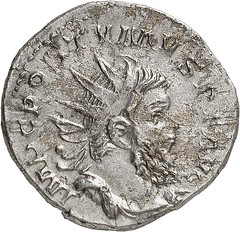
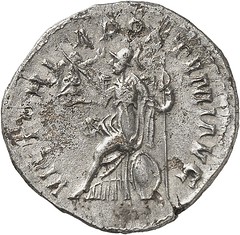
((526 – Postumus. Antoninianus, unknown mint, 263. Second known specimen. Very fine. Estimate: 4,500 euros))
Also a rarity is the extremely rare antoninianus of Postumus, displaying Victoria Postumi Augusti enthroned to the right. This is only the second known specimen (estimate: 4,500 euros).
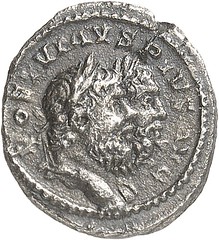
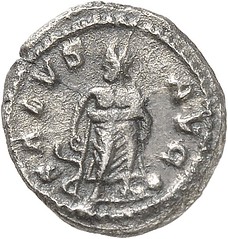
((562 – Postumus. Quinarius, Cologne, 266. C – (cf. 337). Elmer 405. Very rare. Almost extremely fine. Estimate: 3,000 euros))
Let’s not forget about the quinarius of 266, also minted in Cologne. On its obverse it displays the busts of Postumus and Hercules and on its reverse stands a facing Asclepius, a type adopted from the coins of Caracalla (estimate: 3,000 euros).
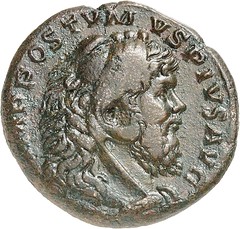
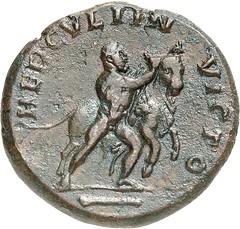
((571 – Postumus. Medallion. Bronze off-metal strike from the die of a quadruple aureus (quaternio), Cologne, end of 267 / beginning of 268. M. Thys, Un médaillon de Postume au type HERCVLI INVICTO, BCEN 29, 1 (1992), pp. 15-18. From the Kölner Münzkabinett T. Kroha 42 (1986), 530. Unique! Almost extremely fine. Estimate: 10,000 euros))
An especially spectacular piece is the medallion struck from the dies of a quadruple aureus. The obverse shows Postumus wearing a lion skin and the obverse features Hercules restraining the Cretan Bull. This is a unique specimen, which was found in the Moselle river around 1960 (estimate: 10,000 euros).
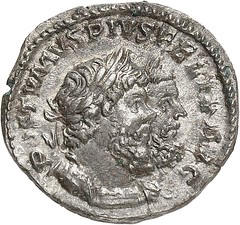
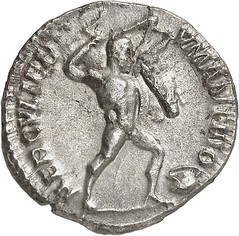
Jacquier offers a small series of denarii, which were minted in honor of Postumus’ 4th consulate using the dies of a series of aurei featuring the labours of Hercules. All show the double portrait of Postumus and Hercules on their obverses. On the reverse Hercules carries the Erymanthian Boar (estimate: 8,000 euros), Hercules cleans out the Augean Stables
(estimate: 7,000 euros), and Hercules steals the apples of the Hesperides (Estimate: 7,000 euros). The series is supplemented by an antoninianus displaying the theft of the magical girdle of Amazonian queen Hippolyta (estimate: 4,000 euros).
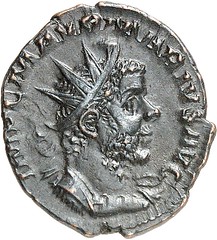
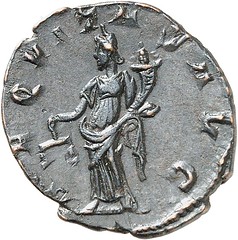
((718 – Marius. Antoninianus, Cologne. C. 2. AGK 10. Elmer 641. Extremely rare. Extremely fine. Estimate: 1,500 euros))
Marius
And these were only Postumus’ strikings. The other emperors also offer numerous show pieces. For Marius let’s take a closer look at his
last and most rare striking. There are only three known pieces in existence, which were all struck from different dies. On its reverse it
features Aequitas (estimate: 1,500 euros).
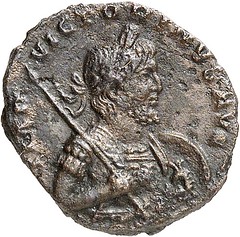
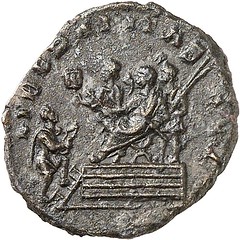
((729 – Victorinus. Denarius (bronze off-metal strike from aureus dies), Trier, ca. beginning of 270. Gilljam, Neue Abschläge der gallischen Kaiser aus einer Kölner Sammlung in: NNB 1987/3, fig. 8. Second known specimen. Almost extremely fine. Estimate: 10,000 euros))
Victorinus
Of the emperor Victorinus there are also several rarities to be discovered. For example, a denarius struck from the dies of an aureus of
one emission, which was produced in the beginning of 270 in the city of Trier. The piece shows a liberalitas scene, which very likely can
be associated with the bestowal of the second tribunician power. It was long considered a unique specimen. Only in 1997 a second piece was
discovered (estimate: 10,000 euros).
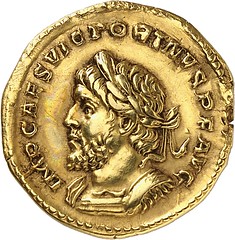
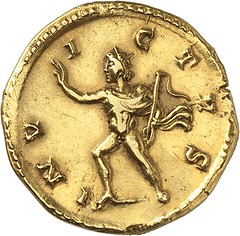
((730 – Victorinus. Aureus, Trier, beginning of 270. C. 45 (600 Fr.). Elmer 679 (this coin).
Schulte 9a (this coin). Calicó 3822 (this coin). From the Récamier Collection, Bourgey Auction (1925), 458. Second known specimen. Good very fine. Estimate: 15.000 euros))
Those who have been missing aurei so far will now find a piece deriving from the Récamier Collection, which was auctioned off by Bourgey in 1925. The reverse features Sol (estimate: 15,000 euros).
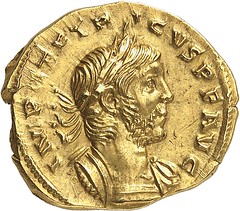
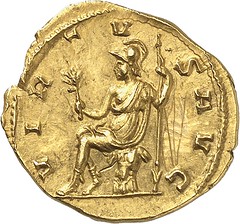
((786 – Tetricus I. Aureus, Cologne, 272. C. 202 (300 Fr.). Elmer 833 (Trier). Schulte 21a (this coin). Calicó 3916a (this coin). From the Montagu Collection, Rollin & Feuardent Auction (1896), 672 (hammer price: 920 gold francs!). Very rare. Extremely fine. Estimate: 25,000 euros))
Tetricus I and Tetricus II
Let’s close this overview with Tetricus I and his son Tetricus II. For the father, an aureus has to be mentioned. Minted in Cologne in 272, it displays Virtus on its reverse. The piece stems from the Montagu Collection and was sold for an unbelievable 920 gold francs in 1896 (estimate: 25,000 euros).
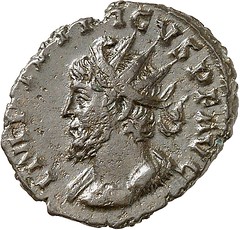
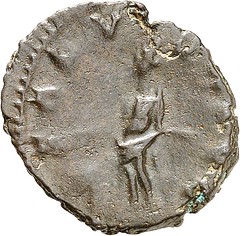
Even more rare is a left facing bust of Tetricus I, which is featured on an antoninianus of 274. Until the discovery of the Normanby Find in 1985, which, among other things, included 16,000 coins of Tetricus, an antoninianus of Tetricus displaying a left facing bust was virtually unknown. Today, only 6 specimens are known (estimate: 2,000 euros).
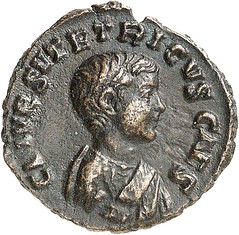
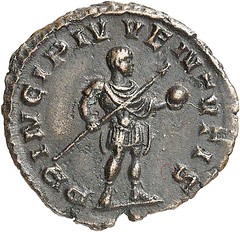
((802 – Tetricus II. Denarius (bronze off-metal strike from the aureus die), Trier, 273. Unique. Extremely fine. Estimate: 8,000 euros))
Not to be passed over is a denarius of Tetricus II, struck from the dies of an aureus showing the emperor’s son as Princeps Iuventutis. This is a unique specimen (estimate: 8,000 euros).
Literature
In combination to the coins, the most important numismatic literature on the Gallic Empire will be on sale.
Auction 41
Please also remember that on September 16, 2016, Auction 41 featuring ancient coins and objects will take place. As they are accustomed to
with Jacquier, aficionados will find an interesting series of Greek coins including many rarities from the area of minor denominations and
bronzes. In the Roman coins section especially the 3rd century is worth a look, after all, this is Paul-Francis Jacquier’s specialty. Just
as ancient minor arts, of which quite a few special pieces will again be offered.
Last but not least, the offerings of numismatic literature are again surely comprehensive, which is not surprising since Paul-Francis Jacquier has been specializing in it for years.
The fully illustrated catalog may be ordered for 15 euros at Paul-Francis Jacquier, Honsellstr. 8, D-77694 Kehl am Rhein, Telephone: +07851 / 1217, email: office@coinsjacquier.com
And to be able to bid online, please register in time at www.coinsjacquier.com.
Please find the auction catalog online.
Auction 42 featuring coins of the Gallic Empire you will find at Sixbid at https://www.sixbid.com/browse.html?auction=2891
Auction 41 featuring ancient coins, ancient art and numismatic literature you will find at https://www.sixbid.com/browse.html?auction=2890

TURTLES AND TORTOISES ON ANCIENT COINS
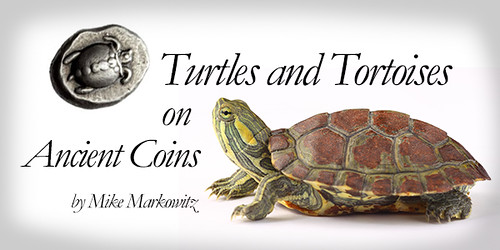
TURTLES ARE AQUATIC; they live mainly in water. Tortoises are terrestrial; they live mainly on land. Both were familiar to ancient people, and they figure prominently as symbols in Greek and Roman mythology, art, literature and, occasionally, on coins.
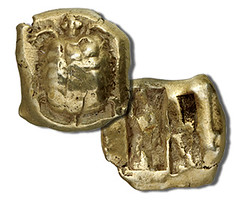 Three species of sea turtle are native to the Mediterranean: the green turtle (Chelonia mydas); the loggerhead (Caretta
caretta); and the mighty leatherback (Dermochelys coriacea), which appears most often on ancient coins.
Three species of sea turtle are native to the Mediterranean: the green turtle (Chelonia mydas); the loggerhead (Caretta
caretta); and the mighty leatherback (Dermochelys coriacea), which appears most often on ancient coins.
When the Swedish naturalist Carl Linnaeus (1707-1778) classified European tortoises, he named one common variety Testudo graeca (“Greek tortoise”). It appears on a rare, early electrum stater (c. 600-500 BCE) from an uncertain mint in Asia Minor.
Aegina Sea Turtles
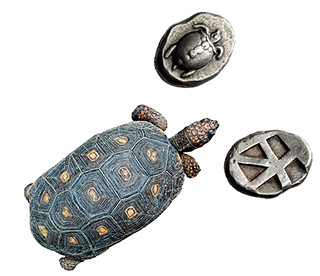 Aegina, an island 30 km (about 20 miles) southwest of Athens, was the first Greek city to mass-produce silver coinage, possibly as early as
580 BCE (Kroll & Waggoner, 339).
Aegina, an island 30 km (about 20 miles) southwest of Athens, was the first Greek city to mass-produce silver coinage, possibly as early as
580 BCE (Kroll & Waggoner, 339).
These coins bore the city’s badge: a sea turtle.
Aegina traded in silver long before the invention of coinage, and one theory is that the turtle was chosen because primitive silver ingots had a rounded “turtle-back” shape. Trace element analysis indicates that the silver came from mines on the island of Sifnos (or Siphnos), about 130 km (80 miles) to the southeast.
The “Aeginetan” weight standard included a didrachm or stater of 12.2 grams, a drachma of 6.1 grams, a hemidrachm or triobol of about three grams and an obol of one gram. The staters are the most common, and have been found in hoards and single finds across the ancient world, often heavily worn from circulation, slashed with test cuts and pocked with “banker’s marks” (small punches that probably validated a coin as “good” in a particular marketplace).
The reverse of the coins bear a variety of geometric punch-marks: a “Union Jack” (a rectangle with intersecting lines resembling the pattern of the British flag), a “mill sail” (four triangles arranged like the sails of a windmill), and a “skew” (a cross with one diagonal line from the center).
Roman Turtles
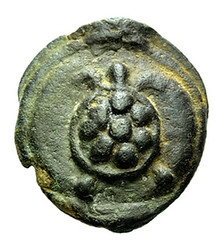 The earliest image of a tortoise on a Roman coin is a rare aes grave (“heavy bronze”) sextans dated to c. 265-242 BCE. Originally one-sixth
of a Roman pound, the sextans was gradually downsized; this piece weighs just under 40 grams. Crudely cast, the coin bears a lumpy tortoise on the
obverse and a six-spoked wheel on the reverse.
The earliest image of a tortoise on a Roman coin is a rare aes grave (“heavy bronze”) sextans dated to c. 265-242 BCE. Originally one-sixth
of a Roman pound, the sextans was gradually downsized; this piece weighs just under 40 grams. Crudely cast, the coin bears a lumpy tortoise on the
obverse and a six-spoked wheel on the reverse.
These animals rarely appear on later Roman coinage except in the form of musical instruments. There were many different sizes and varieties of the ancient stringed instrument generically called a “lyre”, but one type–the chelys–has a sound-box or “resonator” made from a tortoise shell. According to legend, the infant god Hermes invented the chelys when he crawled from the cave where he was born, killed a tortoise, and stretched seven strings across its empty shell. His half-brother Apollo was so charmed by the music that he traded his magical cattle for it, becoming the god of music.
To read the complete article, see:
Turtles and Tortoises on Ancient Coins
(/www.coinweek.com/featured-news/turtles-tortoises-ancient-coins/)
ARTICLE HIGHLIGHTS 1933 GEORGE V PENNY SALE
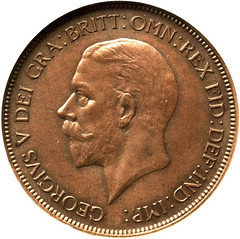
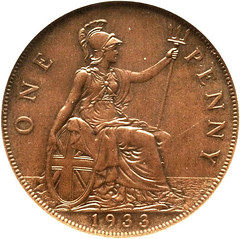
A RARE penny coin that was struck in 1933 is set to reach a world record price of £115,000 when it sells at auction.
Just seven of the coins are believed to have been made by the Royal Mint in that year, making it the rarest British coin of the 20th century.
The coin, which has the head of King George V on one side and Britannia on the other, is in excellent condition and this sale is a “once in a generation opportunity”.
In 1933 the Royal Mint had no plans to produce any new penny coins as there were already plenty in people's pockets.
But a small number - believed to be seven - were produced following special requests for a commemorative coin to mark the year.
Three were created for the King to personally place under the foundation stones of important buildings that were under construction. It is known that two are in the Royal Mint Museum and the British Museum and two found their way to private collectors.
One of the coins was stolen in 1970, during construction at the Church of St. Cross, Middleton, Leeds, when thieves managed to remove it from the church's cornerstone.
There is no record of it ever coming up for sale and the coin's whereabouts remains a mystery.
The Bishop of Ripon ordered that another penny at St Mary's Church in Leeds should be unearthed and sold to prevent it being stolen too. That coin has also been in private hands since 1972.
Four pattern prototypes of the 1933 penny, which uses a design created by French engraver Andre Lavrillier, were also made. One of these set a new record for a 1933 penny earlier this year when it sold for £72,000, but online bidding for this coin is already at £72,600 with two weeks to go before the auction and the estimate is £115,000.
The coin has a great pedigree as it was part of the Norweb collection.
To read the complete article, see:
Rare penny coin set to fetch £115k at auction in 'once
in a generation opportunity' (www.express.co.uk/news/uk/693862/rare-penny-coin-fetch-auction)

STACKS-BOWERS 2016 ANA SALE CURRENCY SELECTIONS
Lot 10048: Siege of Port Hudson J.L. Stockdale 50 Scrip Note
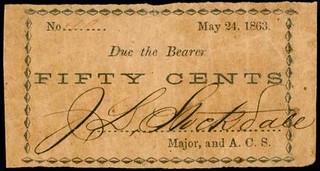
Spectacular Siege of Port Hudson J.L. Stockdale 50 Scrip Note
(Port Hudson, Louisiana). J.L. Stockdale. May 24, 1863. 50 Cents. Very Fine.
Small format scrip note printed on pink paper similar to that of some 1862 and 1863 Confederate Treasury Notes. Diamond shaped border prints. Serial no. 40 penned at top left. Date of May 24, 1863 printed at top right. "Due the Bearer FIFTY Cents" at center. Boldly penned signature of J.L. Stockdale over dotted line with "Major, and A.C.S." printed below.
John Lark Stockdale was born in Edgefield, South Carolina in 1831. He studied medicine in Charleston before moving to Alabama where he practiced as a surgeon. At the onset of the Civil War in 1861 Stockdale entered service as a member of the Alabama Mountain Rangers, later merged into the 8th Confederate Cavalry. He was transferred and commissioned a Major and brigade commissary in 1862.
By 1863 Stockdale was serving as Assistant Commissary of Subsistence for the Confederate's Western Department in Port Hudson, Louisiana. In addition to his duties as A.C.S. he served as the assistant surgeon at the nearby Confederate hospital. It was during Stockdale's time in Port Hudson that this 50 Cent scrip note was issued on May 24, 1863.
The Union siege of Port Hudson had begun just two days before. The fighting continued for 48 days until Port Hudson's commander Major General Franklin Gardner surrendered the stronghold on July 9 after hearing news of the fall of Vicksburg. The surrender of Port Hudson handed control of the Mississippi River to Union forces. While Union commanders granted parole to the enlisted Confederates at Port Hudson, officers were taken north as prisoners of war. Stockdale was sent to the Union POW camp at Johnson's Island, Ohio where he remained until the end of the war. In his post war life he made a name for himself teaching and practicing medicine in Talladega until his death in 1912.
Given the timing of this issue it is doubtful Stockdale issued any great number of these notes. To our knowledge this is the first example of this issue to surface and we believe the note is likely unique. The printed inks are bold and Stockdale's signature is dark and elegantly signed. Overall the paper is in remarkable condition given the circumstances that it endured.

There is a penciled inscription on the back "Confederate States of America Army Money" perhaps written by a Union soldier who took it as a souvenir. This is a note with broad appeal to both Confederate and Louisiana collectors both of which are unlikely to get a second chance at this note for a very long time.
Peter writes:
What do I make of it? A very interesting piece - undoubtedly unique and absolutely "right as rain". Wish I could afford to bid on it!
Just as a quick overview of the "big picture", the siege of Port Hudson was a part of Grant’s 1863 campaign against Vicksburg. On May 27th, 1863, Union General Banks conducted a frontal assault on Port Hudson which failed - and tried again on June 14th and failed again, leading him to settle in for a 48 day siege. When Vicksburg fell to Grant, the Confederate position at Port Hudson was untenable and the garrison surrendered to Banks on July 9th, in effect cutting the Confederacy in half and opening the Mississippi River to Union navigation from its source to the Gulf of Mexico (remember that New Orleans fell to Union General Butler May 1st, 1862)
Lastly, almost anything from the "Old Virginia Collection' has got to be golden!
To read the complete lot description, see:
(Port Hudson, Louisiana). J.L. Stockdale. May 24, 1863. 50 Cents. Very
Fine. (https://auctions.stacksbowers.com/lots/view/3-54QLK)
Lot 10074: Shrewsbury, New Jersey. Alex. McGregor Scrip
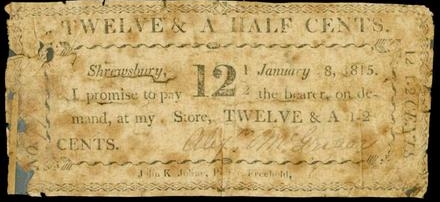
Shrewsbury, New Jersey. Alex. McGregor "at my Store." January 8, 1815. 12-1/2 Cents. Good to Very Good.
(Wait-Unlisted). War of 1812 era scrip style. Imprint of" John K. Joline, Print. Freehold," in center. Denominations on ends and across top. Amazing note and Monmouth County imprint. Last offered in June 1990 and perhaps ex Muscalus Collection. Some petty corner voids are ignored. Unique is more likely than not. The estimate is conservative when weighed to its significance. Ex Smythe 1990 Memphis Sale, June 1990, lot 1404A.
I lived in New Jersey after college, not far from the town of Shrewsbury. Interesting and rare note. -Editor
To read the complete lot description, see:
Shrewsbury, New Jersey. Alex. McGregor "at my Store." January 8,
1815. 12-1/2 Cents. Good to Very Good. (https://auctions.stacksbowers.com/lots/view/3-54K9Y)
Lot 10128: BEP Presentation Book of Engraved Portraits

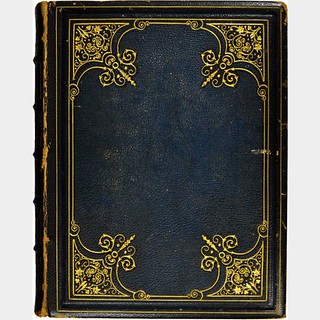
Bureau of Engraving and Printing Presentation Book. Bound volume of Portraits. Volume containing approximately 112 Die Proof Vignettes. Very Fine.
A beautifully prepared bound presentation volume in full Morocco. The covers are subtle blue-green, while the spine has toned slightly to deep olive. 6.25 x 7.75 inches. Gilt ornaments on the cover and spine, which is divided into six panels, two of which bear the gilt titles. The second panel reads, "PORTRAITS AND VIGNETTES", while the fourth is impressed with "ENGRAVED BY THE BUREAU OF PRINTING AND ENGRAVING". Some wear to the cover edges and corner tips worn through, but completely intact and respectably tight otherwise.
The portraits are of government officials, including Presidents Washington through Chester Arthur who left office as the end of 1886, likely dating the volume to the mid-1880s. Also included are various Vice Presidents, Secretaries of State, Secretaries of the Treasury, Secretaries of War, Secretaries of the Navy, Secretaries of the Interior, Postmasters General, Attorneys General, one Chief Justices and United States Senators.
The portraits are clean and bright throughout with separation papers to protect them bound in. Marbled inside covers, that of the front partially separated, and gilt page edges. The final fifth of the volume shows a bit of light waterstaining on the lower right corners of the pages, increasing toward the back. However, on no page does this affect the portrait and it is thus of precious little consequence on this fine book. Scarce and quite desirable. Offered here to a numismatic audience for the first time. Estimate: $2,000 - $3,000.
To read the complete lot description, see:
Bureau of Engraving and Printing Presentation Book. Bound volume of
Portraits. Volume containing approximately 112 Die Proof Vignettes. (https://auctions.stacksbowers.com/lots/view/3-54IPG)
Lot 10339: 1890 $100 Treasury Note
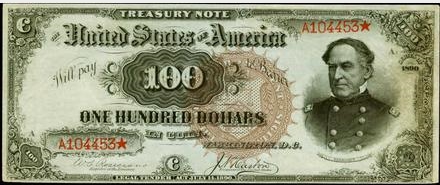
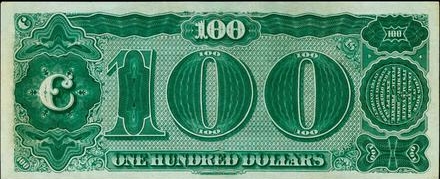
Fr. 377. 1890 $100 Treasury Note. PCGS Extremely Fine 45.
The ornate backed 1890 series has long been a numismatic favorite, and rightfully so. The series was very short lived with the open back designed notes of 1891 replacing them. Official and public opinion of the 1890 series notes was poor during their circulation as they seemed too "busy" and easy to counterfeit. These notes did however trade at a premium when compared to the Legal Tender issues circulating at the same time period. This was due to the promise of being secured by coined precious metal.
Commonly referred to as the "Baby Watermelon", while its higher denomination sibling, the $1000 Treasury Note is classified by those involved in the hobby as the "Grand-Watermelon". This one year type note is represented by only a total of 35 known notes. Of those nine are permanently impounded in museums or government institutions.
To read the complete lot description, see:
Fr. 377. 1890 $100 Treasury Note. PCGS Extremely Fine 45.
(https://auctions.stacksbowers.com/lots/view/3-54PMC)
Lot 10366: 1882 $50 Gold Certificate
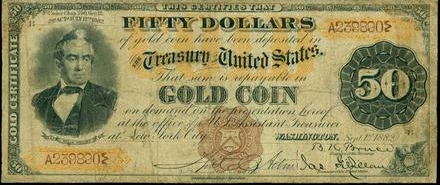
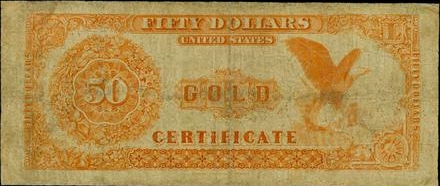
Fr. 1189a. 1882 $50 Gold Certificate. PCGS Fine 12 Apparent. Restorations. Rust Stains on Back.
Anytime an important note is added into the collecting community, it brings joy to all that are involved in this hobby, especially those who are privilege to catalog them. While this note isn't by any means the finest for the series, it has always been a favorite of this cataloger. With the addition of this note, there are now only 13 examples reported to the current census. A mere 9,000 examples were printed and feature the counter signatures of Assistant Treasure Thomas Acton. The note faces up quite nicely retaining good color and eye appeal for the grade. Some restorations are noted on the margins and some small rust specs throughout the back of the note.
To read the complete lot description, see:
Fr. 1189a. 1882 $50 Gold Certificate. PCGS Fine 12 Apparent. Restorations.
Rust Stains on Back. (https://auctions.stacksbowers.com/lots/view/3-54KUR)
To read the earlier E-Sylum articles, see:
STACKS-BOWERS 2016 ANA SALE SELECTIONS
(www.coinbooks.org/esylum_v19n30a20.html)
STACKS-BOWERS 2016 ANA RARITIES SALE SELECTIONS
(www.coinbooks.org/esylum_v19n30a21.html)
COUNTERFEITING MASTERMIND EXTRADITED TO U.S
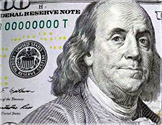 A Lebanese man was extradited from Malaysia to Brooklyn on Tuesday to face federal charges of being the ringleader of a high-end money
counterfeit plot with ties to his mother country and Iran.
A Lebanese man was extradited from Malaysia to Brooklyn on Tuesday to face federal charges of being the ringleader of a high-end money
counterfeit plot with ties to his mother country and Iran.
Louay Ibrahim Houssein was arrested in Kuala Lampur, Malaysia in 2014 on charges of making bogus Benjamins. On Tuesday, the 42-year-old was hauled into Brooklyn Federal Court to stand before U.S. Magistrate Judge Lois Bloom. Earlier Tuesday, U.S. Magistrate Judge Robert Levy put him on lockdown until the terms of his bond package could be hammered out.
Houssein is the subject of a "long-term undercover investigation" that went on for years. He allegedly sold thousands of dollars in counterfeit money to a Secret Service agent posing as a member of a New York-based "criminal enterprise."
He is accused of selling the agent nearly $150,000 in "high quality" fake $100 bills, and nearly $150,000 in phony euros.
Houssein tried it again in October 2013 on the island of Cyprus, to the tune of $300,000 in counterfeit currency, the U.S. Attorney's Office said in a statement.
In June 2014, his co-defendant, Nazer A-Shekh Mosa aka Mohammed Hasan Haidar, also a Syrian national, sold an undercover agent $170,000 in counterfeit money.
He was arrested, pleaded guilty in April and awaits his sentence.
A third, U.S.-based co-conspirator, Moufak Al Sababi, was arrested in August. He pleaded guilty to conspiracy and got a three-year sentence.
The men were part of an "international criminal network" that sells counterfeit U.S. currency around the world, and claim to have as much as $800 million in high-quality fake money for sale to clients in Iran and elsewhere, prosecutors said.
They're also accused of offering to get weapons, drugs and fake money through U.S. ports.
To read the complete article, see:
Counterfeiting Mastermind Extradited to
U.S (www.courthousenews.com/2016/07/27/counterfeiting-mastermind-extradited-to-u-s.htm)
MAN TRIES SPENDING HOMEMADE $MILLION BILL
Talk about leaving the store with a big chunk of change.
A Lexington man is accused trying to use a fake $1 million bill to pay for his purchases at a Walmart.
Michael Anthony Fuller, 53, of 3 Parker St., walked into the Walmart on Lowes Boulevard in Lexington on Nov. 17. He shopped for a while, picking up a vacuum cleaner, a microwave oven and other merchandise, totaling $476, an arrest warrant says.
When he got to the register, Fuller gave the cashier the phony bill, saying that it was real.
Store staff called police.
Fuller was later charged with attempting to obtain property by false pretense and uttering a forged instrument, both felonies, court records show.
A warrant says of the fake million-dollar bill: "There is no such thing."
The largest bill in circulation is a $100 bill. In 1969, federal officials discontinued the use of $500, $1,000, $5,000 and $10,000 bills because of lack of public use.
To read the complete article, see:
Lexington man charged with making a fake $1 million bill and trying to spend it
(www.journalnow.com/news/local/lexington-man-charged-with-making-a-fake-million-bill-and/article_0ea7afdb-7f8c-58a9-a345-1377e706a98a.html)
BEP RESEARCHING NEW ANTI-COUNTERFEITING MEASURES
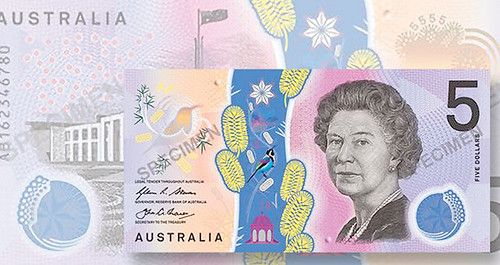
A glimpse at the Treasury Department’s plans for the future of American paper money was offered July 8 at FedBizOpps.gov, the federal business opportunities website for vendors interested in doing business with the government.
An announcement there says that the Bureau of Engraving and Printing will issue a solicitation on or about July 28 “for the research and development of new conspicuous and device-assisted security features” for use in protecting the next generation of Federal Reserve notes from counterfeiting threats.
It added that the BEP also wants to provide “the general public with a user friendly feature to quickly and confidently validate notes passed in common, everyday transactions.”
The BEP says it would like to develop new devices and features based on raised intaglio printing, and what it calls “optical waveguide technology.” Perhaps this is a clue that finally the United States will see the windows, holograms, plastic films, and coded fiber optics becoming the standard elsewhere in the world but so far absent here.
One can look Down Under for what might be in store.
The Reserve Bank of Australia is issuing a new $5 note in September that will be the first release of the bank's "Next Generation Banknote Program."
That $5 note will include a tactile feature aimed at helping the visually impaired, as well as security enhancements that include two clear windows — a large one that runs up the middle of the note and another smaller one in the lower right corner — and Omron rings, which is a pattern of small circles, usually yellow in color. (The most recent versions of Federal Reserve notes above the $2 denomination already have the Omron rings feature.)
Other currency issuing entities, including the Bank of England recently, have also moved to polymer as the material they print their notes on.
To read the complete article, see:
Are holograms and
windows to be part of future Federal Reserve note technology?
(http://www.coinworld.com/news/paper-money/2016/07/bep-seeks-solicitations-on-advanced-note-technology.html)
To read the complete BEP solicitation, see:
BEP-RFP-16-0443
(www.fbo.gov/index?s=opportunity&mode=form&id=ee0249d77eca9cf48ee592c35709ac15
&tab=core&_cview=0)
THE BOOK BAZARRE
KOREAN WAR U.S. MARINE HORSE WINS DICKIN MEDAL
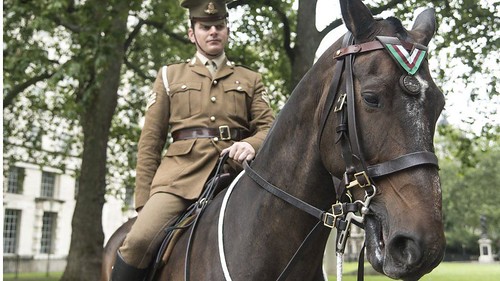 It's 63 years since Sergeant Reckless, a chestnut mare, served the US in the Korean War.
It's 63 years since Sergeant Reckless, a chestnut mare, served the US in the Korean War.
Now she's been honoured with the PDSA's Dickin Medal, the animal equivalent of the Victoria Cross.
Reckless was wounded twice, but lived until she was 20 years old and died in 1968.
Bred as a racehorse, Reckless' journey with the US Marine Corps began in October 1952 after she was bought for $250 - around £190 in today's money.
Soldiers nicknamed her Reckless because the gun she carried ammunition for - the Recoilless Rifle - was so dangerous it was coined the "reckless" rifle.
In the five-day fight, 28 tons of bombs were reportedly dropped.
The terrain was described by Lieutenant Colonel Andrew Geer as a "smoking, death-pocked rubble".
On one day alone, Sergeant Reckless made 51 trips during the 1953 Outpost Vegas battle, carrying more than 9,000lb of supplies and walking more than 35 miles.
The Mongolian mare was nominated for the bravery award by author Robin Hutton who spent six years researching and writing her biography.
He said: "She was loved by the marines, they took care of her better than they took care of themselves, throwing their flak jackets over her when incoming fire was heavy."
At the ceremony in Victoria Embankment Gardens on Wednesday, Haldalgo the horse received the PDSA Dickin Medal on behalf of Reckless.
Maria Dickin, founder of animal charity the PDSA, established the Dickin Medal in 1943 for outstanding acts of bravery in war.
Most have gone to homing pigeons.
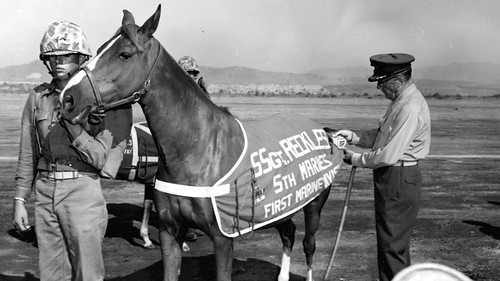
To read the complete article, see:
War horse
Sergeant Reckless has finally been honoured for her bravery
(www.bbc.co.uk/newsbeat/article/36905817/war-horse-sergeant-reckless-has-finally-been-honoured-for-her-bravery)
To read an International Business Times article, see:
US Marine Corps horse
Sergeant Reckless honoured for bravery during Korean War
(http://www.ibtimes.co.uk/us-marine-corps-horse-sergeant-reckless-honoured-bravery-during-korean-war-1572920)
To read the complete article, see:
U.S. Marine Horse ‘Sgt
Reckless’ Awarded Posthumous Medal Of Valor Read more at
http://www.inquisitr.com/3358373/u-s-marine-horse-sgt-reckless-awarded-posthumous-medal-of-valor/#kopQHvqGSRpIDpxM.99
(www.inquisitr.com/3358373/u-s-marine-horse-sgt-reckless-awarded-posthumous-medal-of-valor/)
From the book's web site:
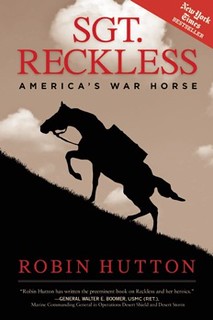 This site is dedicated to a remarkable hero - a small Mongolian mare named Reckless - who became a National hero in 1954 when an article
ran in the Saturday Evening Post about her heroics during several battles in the Korean War. LIFE Magazine ran a Special Collector’s Edition
in 1997 entitled “Celebrating our Heroes,” and there’s Reckless listed alongside the likes of George Washington, Thomas Jefferson, Abraham Lincoln,
Martin Luther King and Mother Teresa ... just to name a few!
This site is dedicated to a remarkable hero - a small Mongolian mare named Reckless - who became a National hero in 1954 when an article
ran in the Saturday Evening Post about her heroics during several battles in the Korean War. LIFE Magazine ran a Special Collector’s Edition
in 1997 entitled “Celebrating our Heroes,” and there’s Reckless listed alongside the likes of George Washington, Thomas Jefferson, Abraham Lincoln,
Martin Luther King and Mother Teresa ... just to name a few!
Her incredible story is inside - you are in for real treat!
For more information, see:
www.sgtreckless.com
RUSSIANS PROMOTE CAT FOR NEW BANKNOTE
 He won popularity through slightly menacing campaign pledges such as ‘Only mice don’t vote for Barsik’.
He won popularity through slightly menacing campaign pledges such as ‘Only mice don’t vote for Barsik’.
And now it appears that after winning the unwavering support of the people of Barnaul in south central Russia, Barsik the cat has set his sights on the loftier goal of appearing on a bank note.
The feline first shot to fame last December when he topped an unofficial opinion poll of mayoral candidates for the city in a protest against corruption.
And with more than 90% of the vote, the cat clearly felt he had the mandate to pursue appearing on the new Ruble notes.
In a message posted out on his social media account (People’s Mayor Barsik) the cat revealed his ambition to appear on either the 200 or 2,000 Ruble note. Russia is holding a public vote on new bank note designs and Barsik is hoping his supporters will see his dream’s realised.
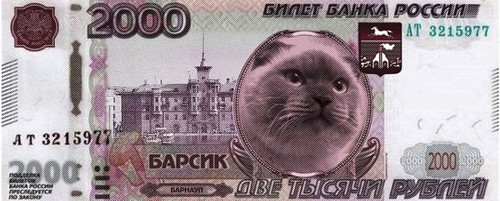
To read the complete article, see:
Cat that
Russian city wants as mayor is now aiming to get face on bank note
(http://metro.co.uk/2016/07/26/cat-that-russian-city-wants-as-mayor-is-now-aiming-to-get-face-on-bank-note-6031229/)
FEATURED WEB SITE: NUMISMATIC FAKES
This week's Featured Web Site is the Numismatic Fakes blog.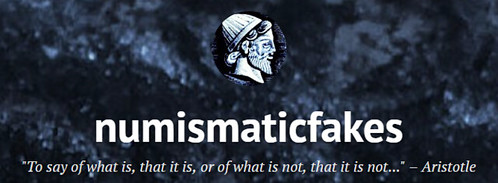
https://numismaticfakes.wordpress.com/

